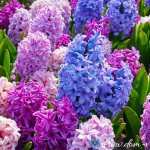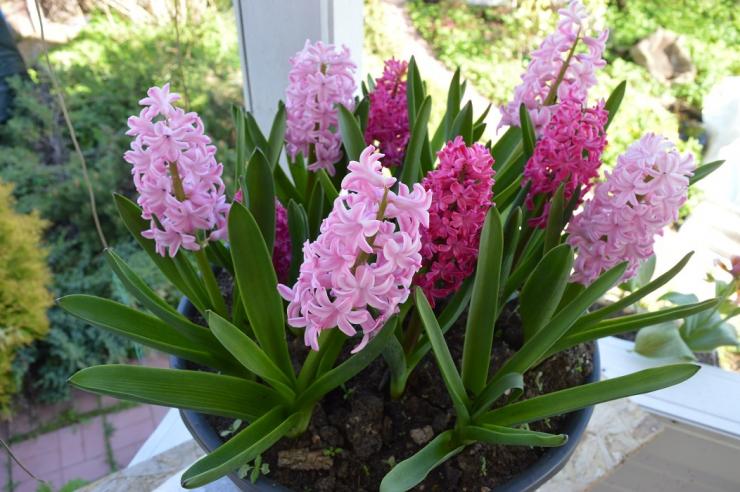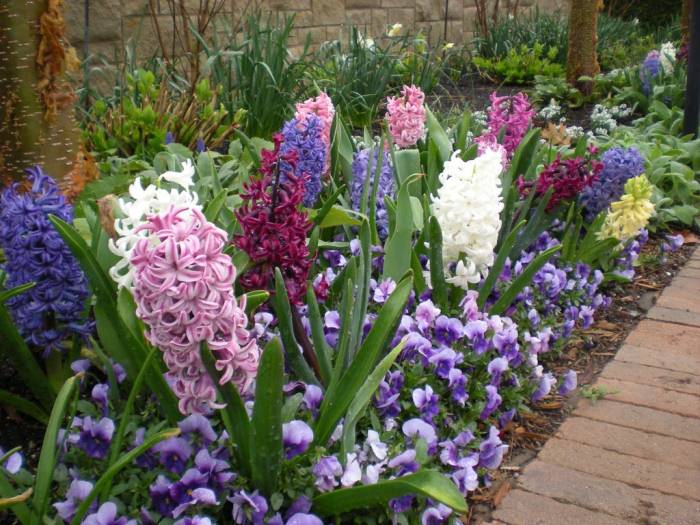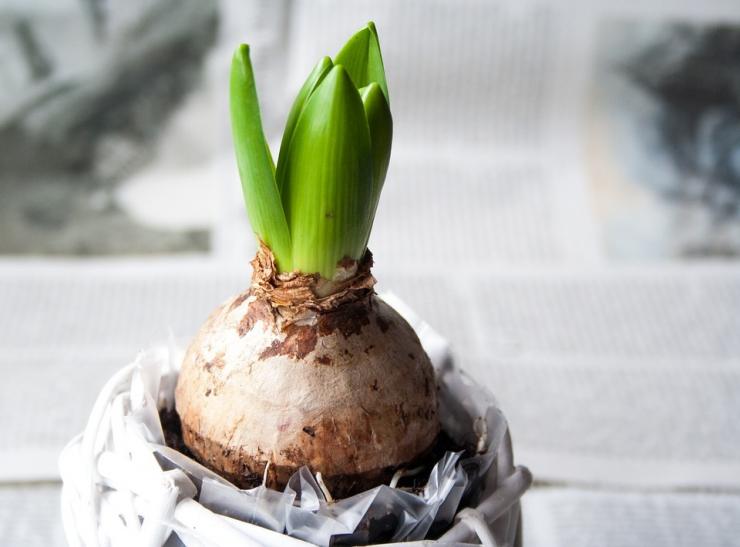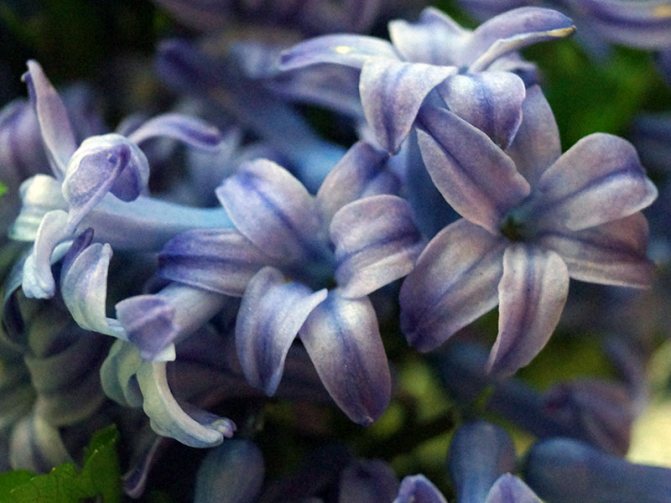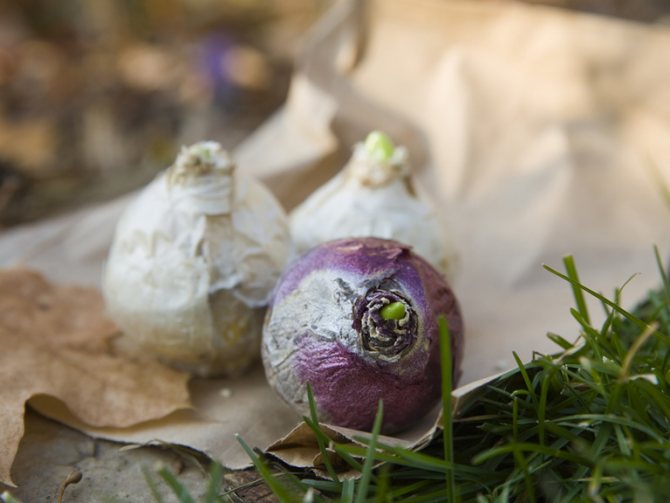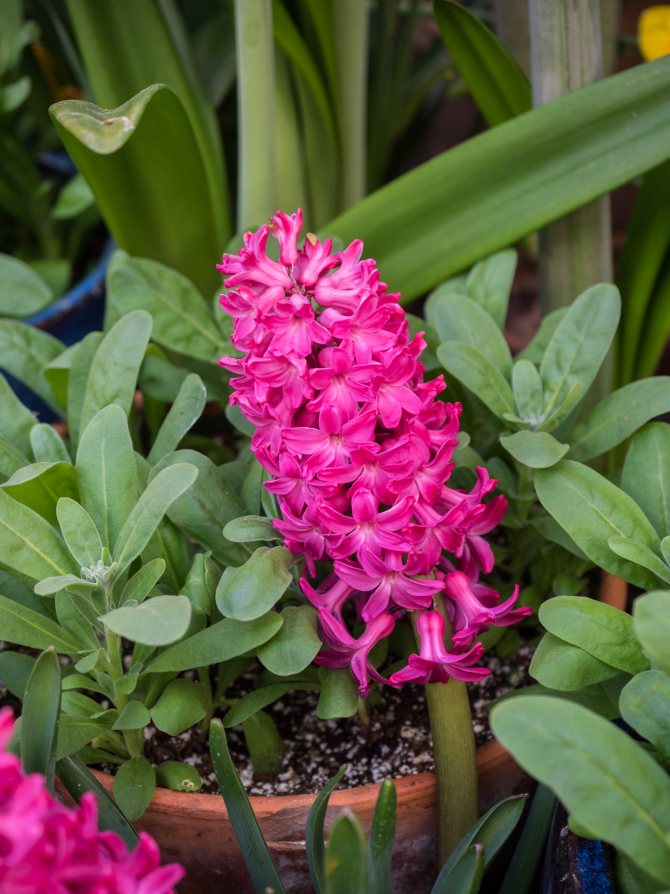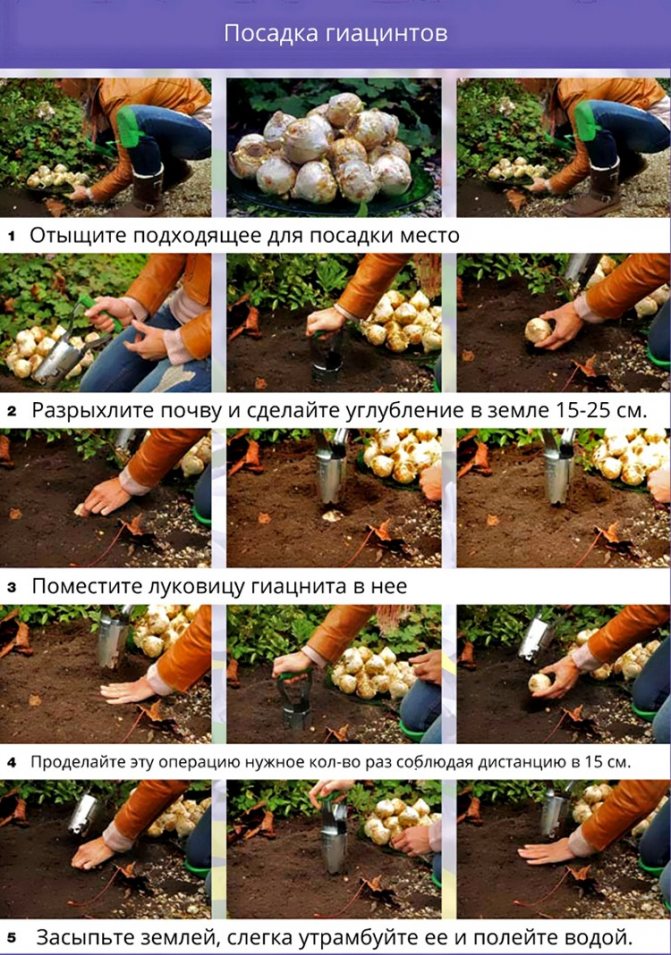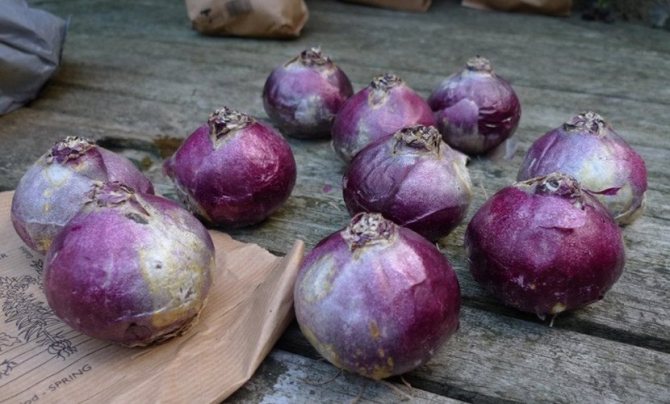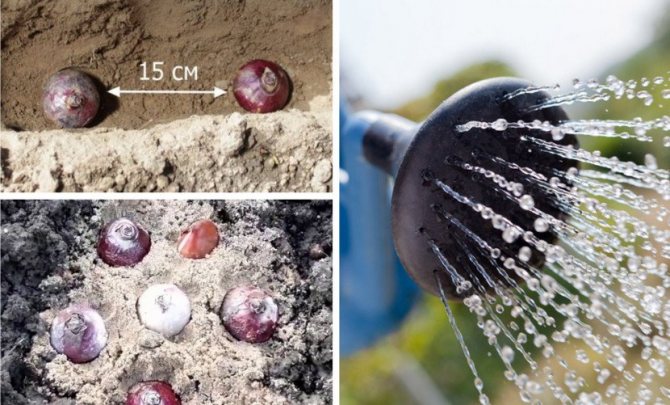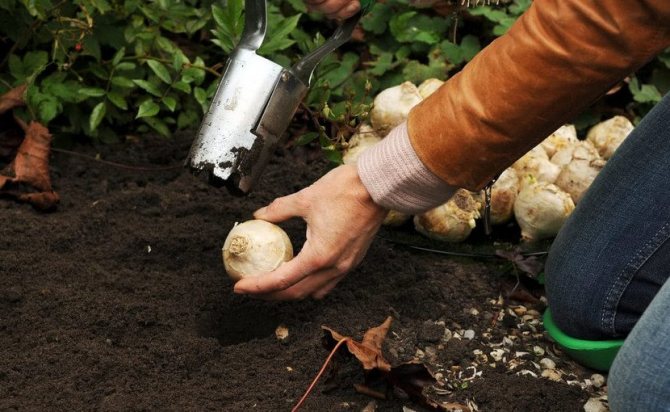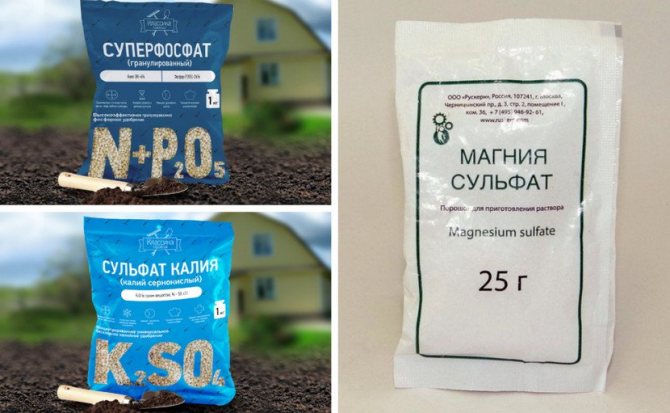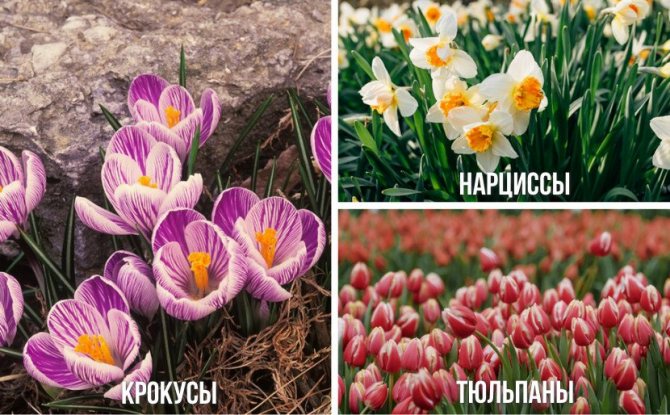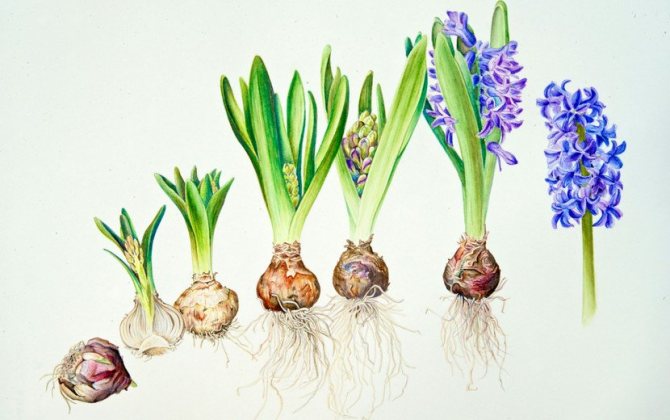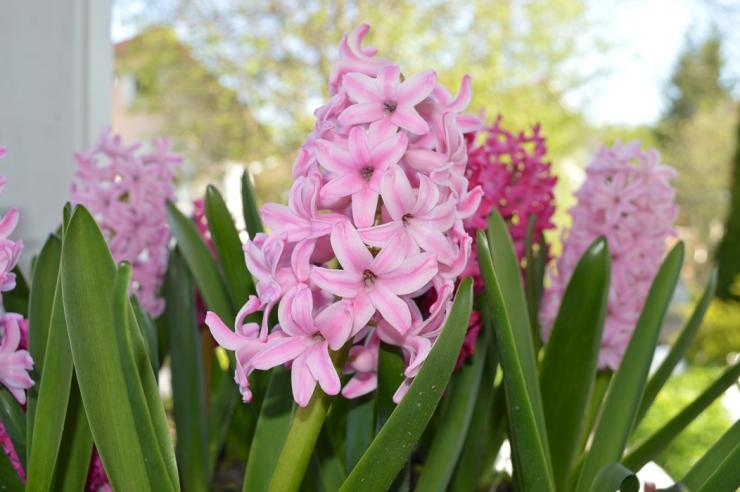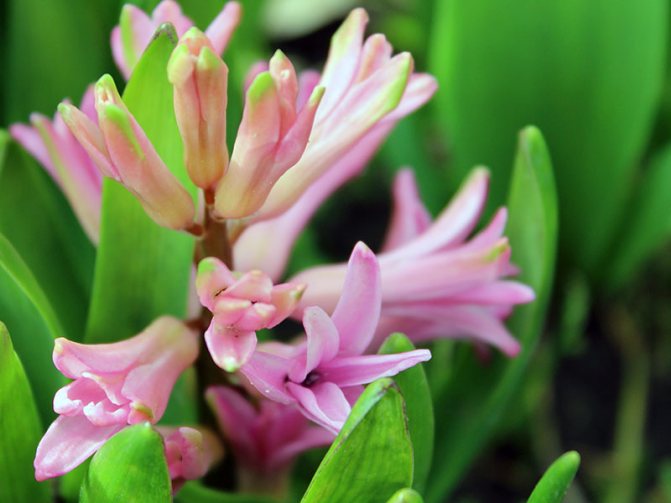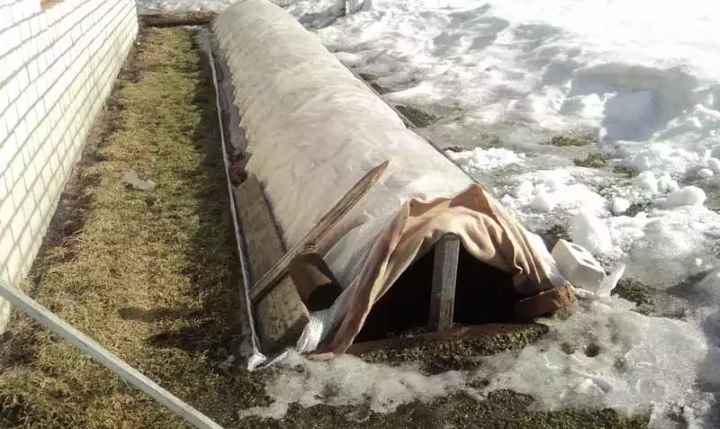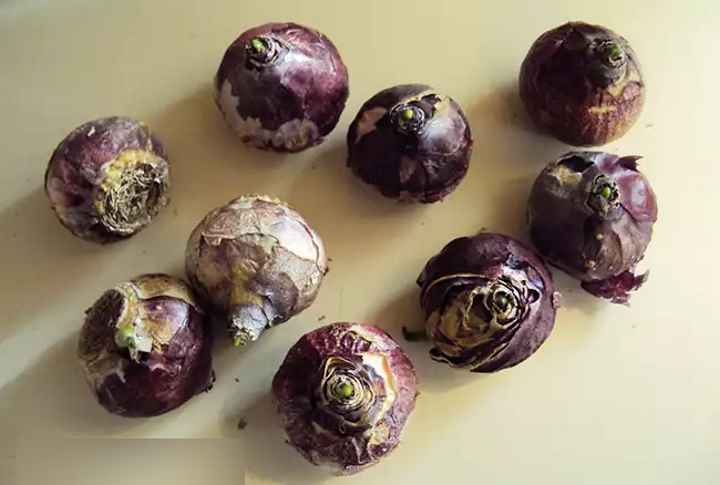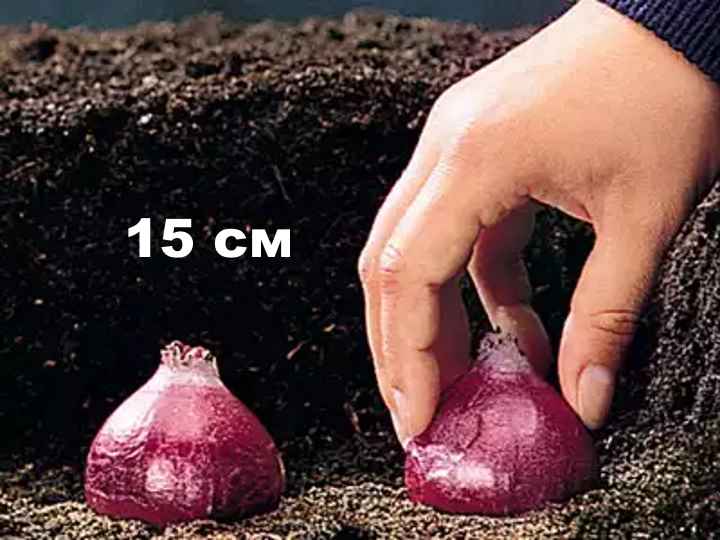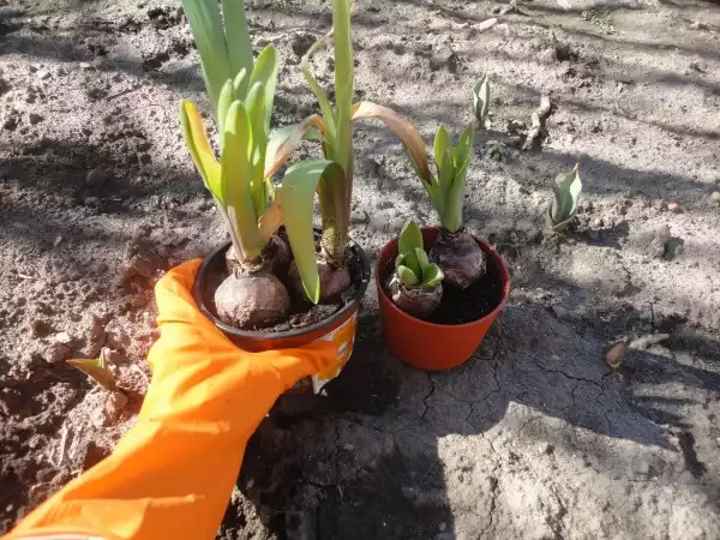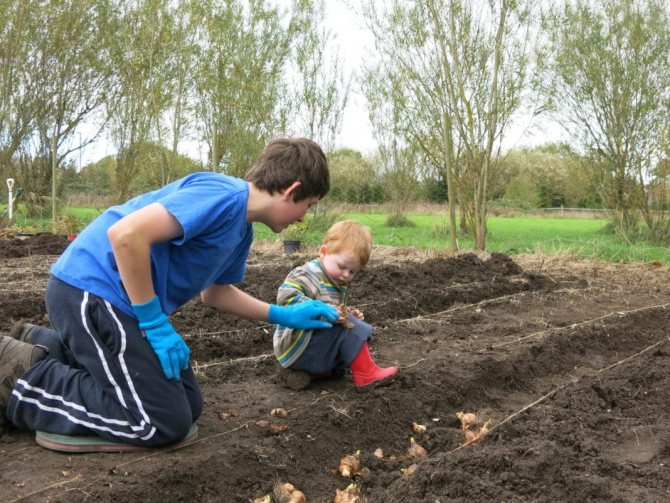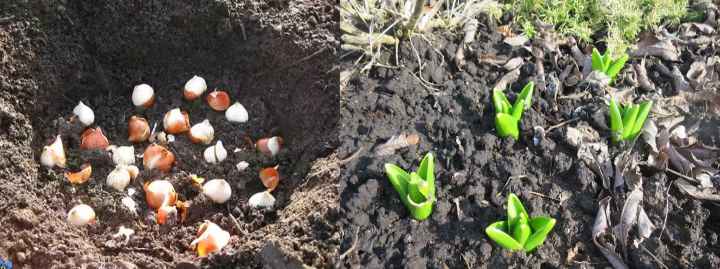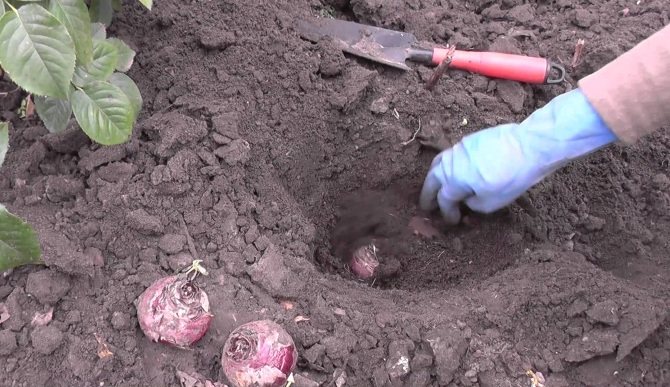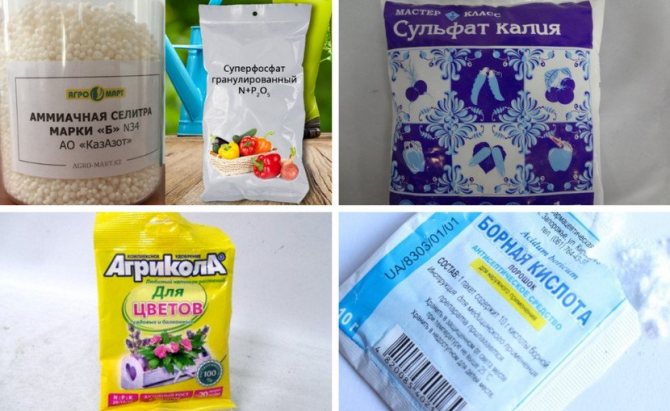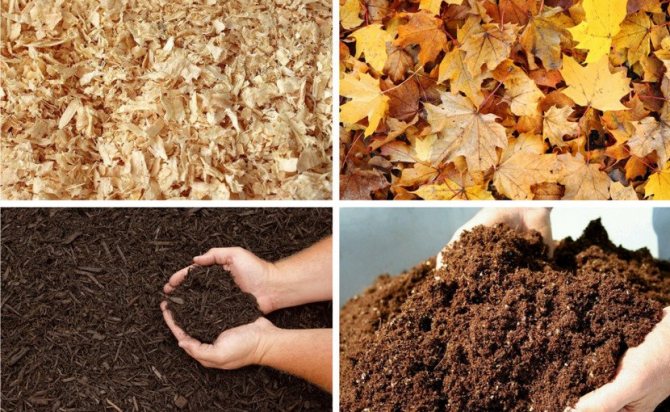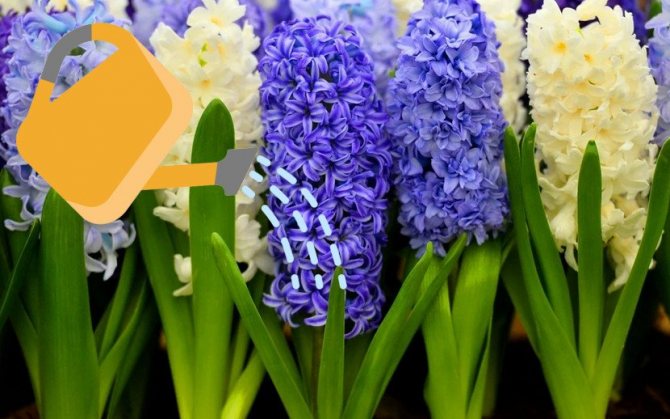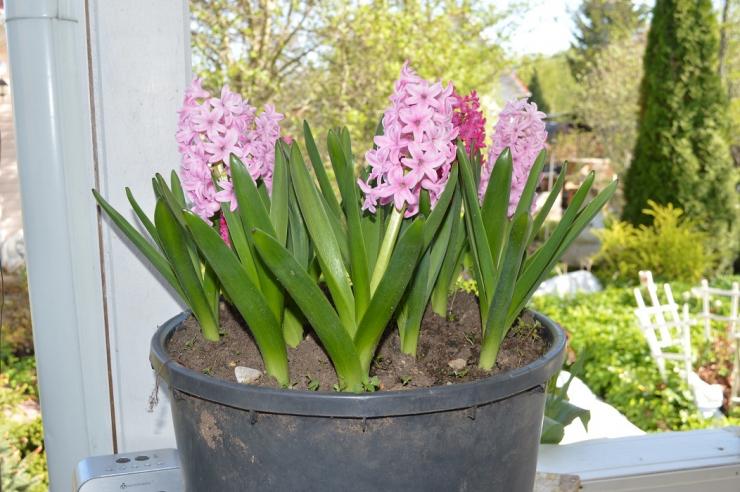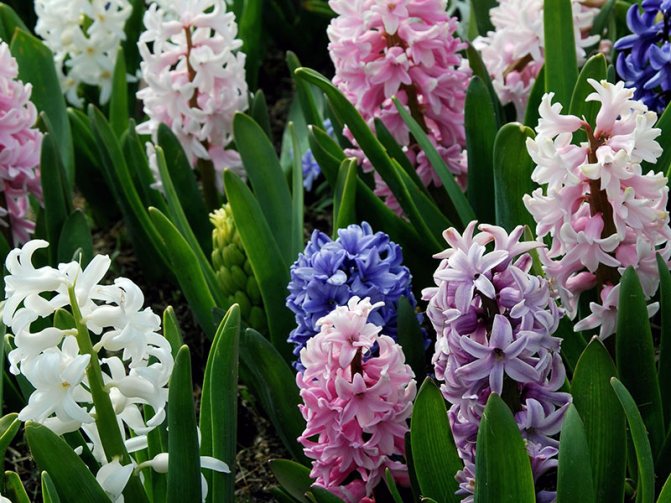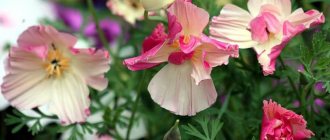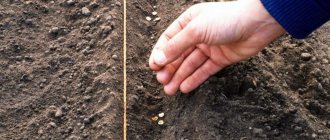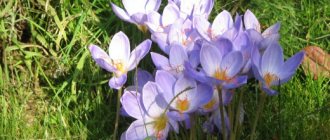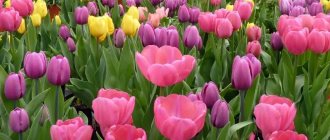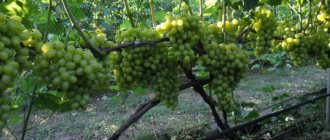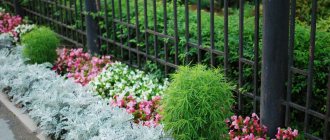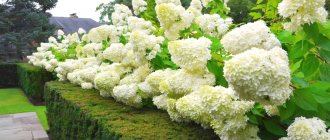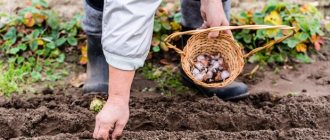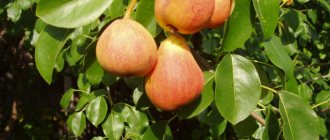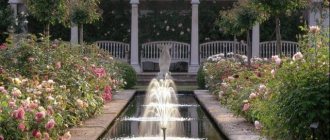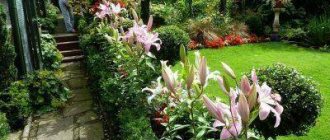The first spring months delight gardeners with the lush bloom of bulbous flowers, among which the bloom of hyacinths amazes with its tenderness. Their cone-shaped inflorescences are painted in almost all sorts of colors from the rainbow: pink, red, purple, yellow or cream. And of course, they are snow-white.
The cultivation of hyacinths, the abundance of flowers and the duration of flowering depends on when the hyacinths were planted in the fall. Whether the terms of their transplant were met. After all, these plants require an annual change of the place in which they will grow. Otherwise, their flowering weakens. We are happy to enjoy spring primroses in the garden, so we follow the rules and dates for planting hyacinths in the fall.
Reasons for planting hyacinths in autumn
It is extremely rare for bulbous flowers to be planted in spring: it is difficult and risky. And planting hyacinths should be carried out exclusively in the fall. During the summer, the bulbs have time to accumulate nutrients and gain new vitality. By autumn, the growth processes freeze, the plant rests, at this time it is transplanted to a new place.
If you do this earlier, even at the end of summer, there is a high risk that the bulbs will not only take root, but also grow, and the young shoots will freeze. Late planting in November is fraught with the fact that the bulbs will not have time to take root before the frost: this takes about 3-4 weeks.
Spring planting of bulbs is out of the question, except for the case when hyacinths are purchased in pots and planting in open ground will be painless for the plants. It is necessary to plant bulbs without soil in the ground so early that in most regions this is unrealistic, and the simultaneous rooting and preparation for flowering will cause stress in the hyacinth, which it may not survive.
You can plant bulbs in open ground in the spring, the flowering of which was artificially caused at home in the winter (for example, by March 8). After flowering, the peduncle is cut off, and the bulb with a clod of earth is transplanted into the garden bed. The success rate of such an event is quite high.
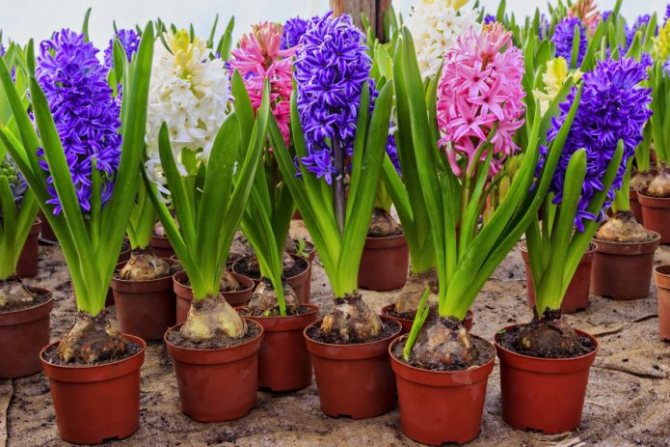
If hyacinths bloomed in pots in winter in your house, they can be carefully transplanted into the garden in spring, but bulbs without soil are not worth it
Thus, there is no need to talk about the disadvantages of autumn planting: if the timing is right, the bulbs will surely take root, and bloom early in the spring. The advantages are obvious: it is at the end of summer that the bulb fully ripens and acquires the ability to quickly root. And the gardener, before the autumn planting, has time to carefully prepare the flower garden for planting, which does not happen in the case of spring work.
How to choose hyacinth bulbs
A healthy bulb is the key to a beautiful strong flower, therefore, the choice of planting material must be approached very responsibly.
Selection rules:
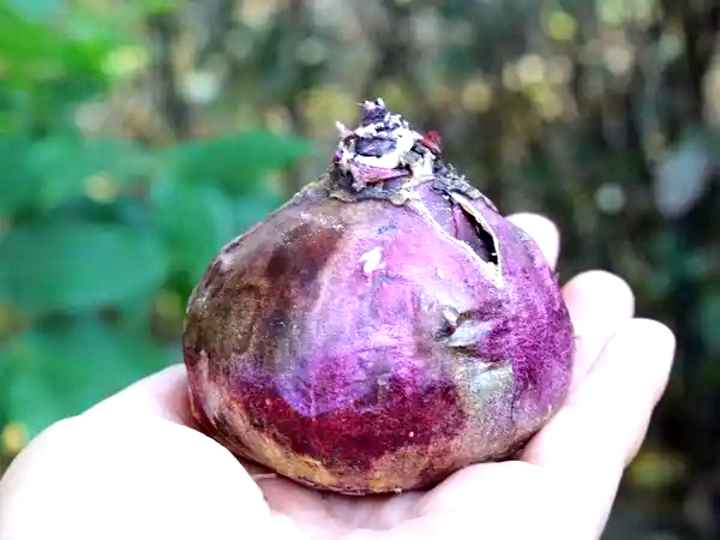

opt for bulbs with a diameter of 4-6 centimeters;- make sure that the bulbs are free of cracks, damage, signs of decay and stains;
- see that the surface is smooth and the bulb is elastic;
- large bulbs - for distillation, and medium-sized ones - for planting in the garden;
- the color of the scales will tell you about the color of the hyacinth.
How to plant hyacinths in the fall
Planting hyacinths in autumn is practically the same as planting tulips or daffodils and is available even to a beginner.
Landing dates
The exact timing of planting hyacinths depends on the climate of the region, the current weather and the size of the bulbs. It is important that by the time of planting the soil has already cooled down to 5–10 ° C: this is a comfortable interval for rooting. In warmer soil, shoots germination is possible, and in colder soil, the death of bulbs due to incomplete rooting.
Large bulbs (from 5 cm in size) are tried to be planted earlier than small ones: they form roots more slowly. Small ones (up to 3 cm) do it faster, so they are planted 7-10 days after the largest ones.
Regarding the regions, the approximate planting dates are as follows:
- south of Russia - from mid-October, within a month;
- the middle band - the last days of September - the first decade of October;
- north of the European part - mid-September - early October;
- Urals and Siberia - the last days of August - mid-September.
Site preparation and planting
A flower bed for hyacinths is equipped on a flat area without stagnant water, protected from the winds. Areas completely exposed to the sun are not optimal; it is better if the flowers are in partial shade for at least a few hours in the middle of the day. Do not plant hyacinths where any bulbous plants have grown shortly before.
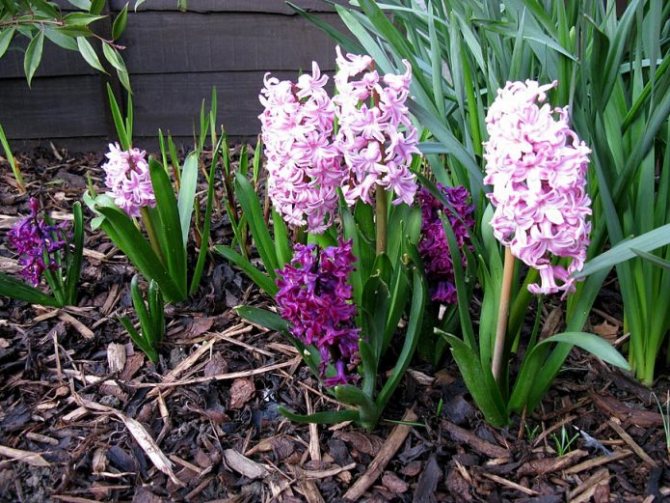

Hyacinths thrive in light shade, such as against a house wall
Flower bed preparation
The best soil is close to neutral (pH above 6.5), breathable and sufficiently water-absorbing. Clay soils are corrected by the introduction of sand and peat, too acidic - they are lime.
When digging, carried out 2-3 weeks before planting, well-rotted manure (2 buckets per 1 m 2), wood ash (0.5 l) and superphosphate (up to 150 g) are introduced into the soil. Additional nitrogen fertilizers, other than those contained in humus, are not applied under hyacinths. You can add 1 tbsp. a spoonful of any magnesium salt.
Preparing the bulbs
The bulbs for planting should be healthy, preferably of medium size, the ratio of the diameters of the bottom to the bulb is about 1: 1.5. Before planting, they are kept for 20-30 minutes in a pink solution of potassium permanganate. Large bulbs are planted to a depth of 15 cm, medium ones - 7–8 cm.
Approximately: the depth of the hole is twice the diameter of the bulb.
Landing
Hyacinths are planted like this.
- Wells of the required depth are prepared at a distance of 10–20 cm from one another. Drainage is placed in the holes - coarse sand with a layer of 3-4 cm. A little ash can be added to the sand. If very dry, lightly watered.
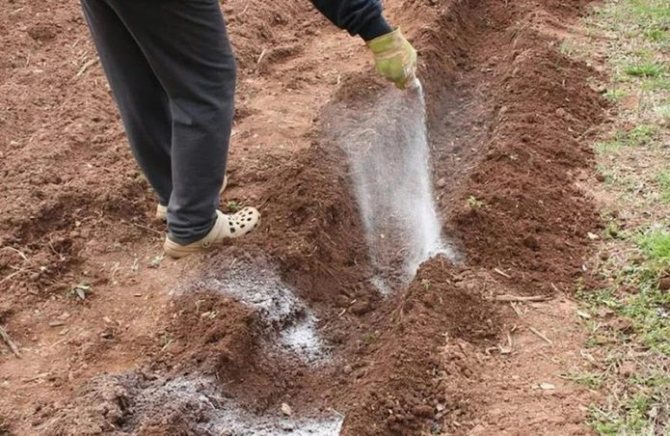

Instead of separate holes, you can prepare a common trench, which is sprinkled with plenty of sand
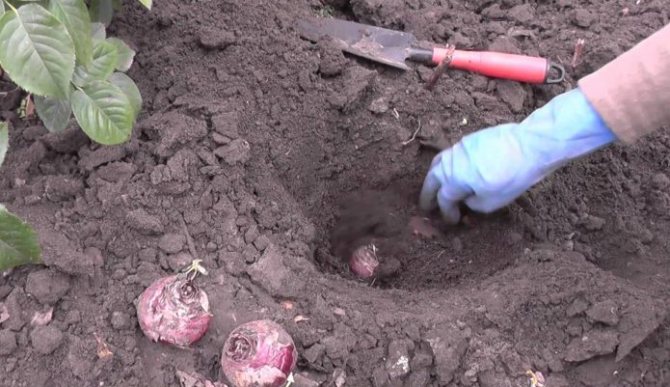

Each onion is placed in a hole or trench firmly, but almost without pressing on it, so as not to damage the bottom.
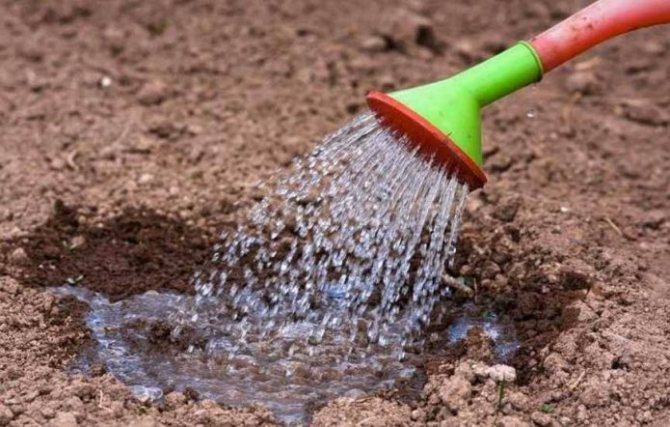

The soil should be slightly moistened without creating a swamp.
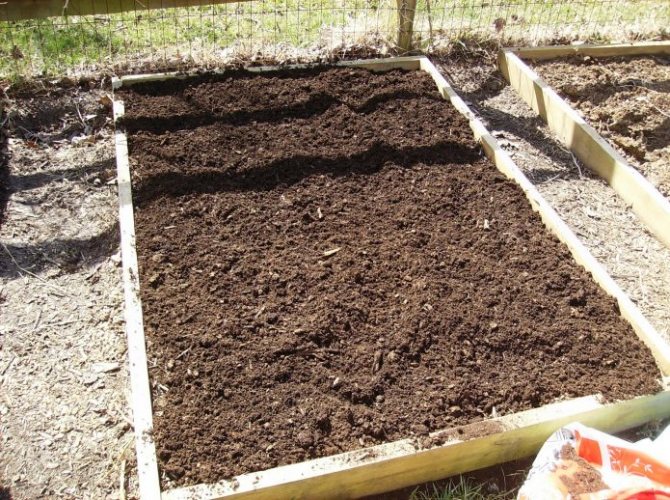

Mulch will prevent the soil from drying out excessively and warm the flower bed a little before snow falls
Video: basic rules for planting hyacinths
Planting hyacinths on the site is not difficult: they are not very picky about choosing a place, the planting technique itself is simple, but you need to do it on time. No more than a month is allotted for planting, the dates fall on the first half of autumn.
Hyacinths are colorful spring bulbous plants with dense conical or cylindrical inflorescences. Hyacinths bloom in early spring, then the ground part of the plants dies off, and the bulb lies in the warm summer soil at rest for about six months, forming the rudiments of children and shoots with leaves and inflorescences. The peculiarity of growing hyacinths is that their bulbs must be dug up annually, and they do this in the summer.
When should hyacinth bulbs be planted in the ground?
What difficulties can arise when planting hyacinths in the fall?
And they appear if the deadlines for when to dig out and plant the bulbs of hyacinths are not met. So spring planting will not produce flowers in the first year of growth.
If hyacinths are planted in a shaded area, they will bloom sparsely.They require well-lit flower beds that are protected from drafts. In addition to the sun, these plants need warmth. And in the wind they will be cold.
Sometimes hyacinth bulbs begin to rot from groundwater, but only in a situation when they are very close. In this case, you need to raise the flower beds, increase the height of the drainage and make the surface of the bed sloped.
Three reasons at once become the reason that their inflorescences grow short, falling out of the sockets, their flowers turn out to be underdeveloped. And the reasons for this are: early planting, excessive moisture in the ground, failure to comply with the rules for storing bulbs.
When to plant hyacinths in the ground in autumn
Planting dates for hyacinths
Experts and experienced gardeners believe that autumn planting of hyacinths is preferable to spring planting. And when exactly should hyacinths be planted in the ground in autumn? What month to plant hyacinths? The timing of planting hyacinths in the fall depends on the climatic features of the area and weather conditions. In Ukraine and Moldova, hyacinth bulbs are planted until late autumn, and in less warm regions, planting begins earlier - before the frost begins, the roots of the planted bulbs should have time to form.
When to plant hyacinths in the fall in the suburbs
Planting hyacinths in the fall in the suburbs, in the middle zone, is carried out in late September or early October. If suddenly the cold weather comes earlier, you need to protect the planting of hyacinths from them with a covering material. If planted too early, hyacinths can not only acquire roots, but also germinate, and this cannot be allowed. Therefore, the film on the site, if necessary, is kept for no longer than three weeks.
Orientation to the lunar calendar
The lunar calendar of the gardener and the gardener depends on the phases of the moon and the zodiac. It indicates favorable and unfavorable days for the timing of planting hyacinths in the fall. These terms are marked with dates:
- September - from 3 to 7, from 18 to 23;
- October - 2-6, 18-20, 28-30.
The calendar also indicates the dates when it is categorically not recommended to plant anything:
- during the full moon - September 9 and October 9;
- full moon - September 25, October 24.
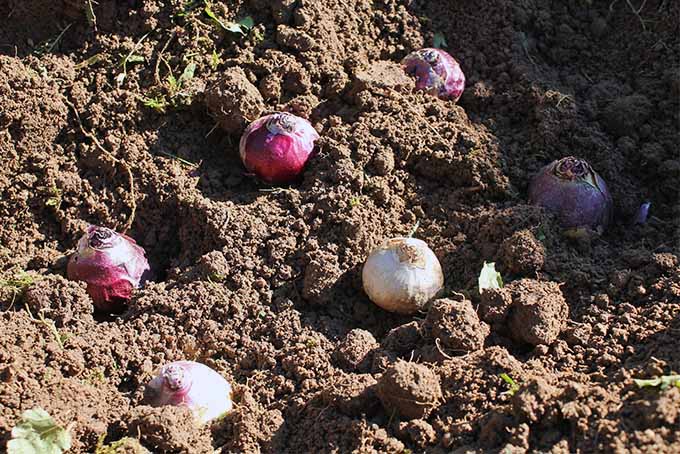

Planting hyacinths in the ground before winter
Soil for hyacinths
The area for hyacinths should be protected from the wind, well lit, but these flowers do not tolerate excess sunlight. Hyacinths are often planted near shrubs or trees, although this is far from the best place for flowers, since the roots of large plants absorb almost all nutrients from the soil. Hyacinths grow best in neutral, drained soil with a pH of at least 6.5, consisting of turf, leafy soil and sand. It is advisable to lime the acidic soil, and add sand to the clay soil, and this must be done in advance.
Before planting hyacinth, the soil on the site is dug up to a depth of 40 cm with wood ash or dolomite flour in the amount of 200 g per m², superphosphate in the amount of 60-80 g per m² and humus or rotted manure in the amount of 15 kg per m² of the site ... Hyacinths will not need nitrogen fertilizers either in autumn or in winter. The soil is prepared for planting in late July or early August.
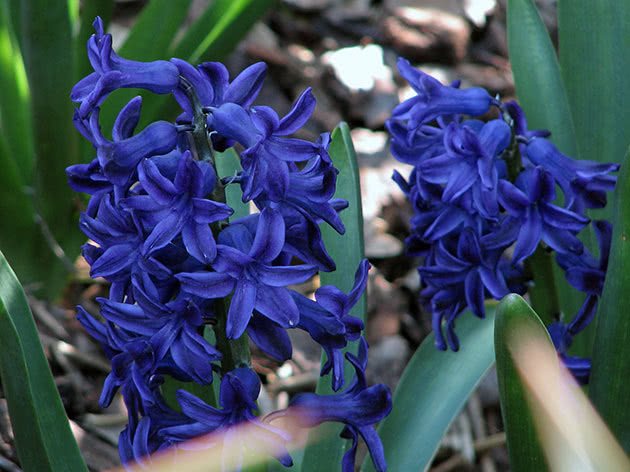

How deep to plant hyacinths
Large hyacinth bulbs with a diameter of about 5 cm are immersed in the soil by 15-18 cm, and standard-sized bulbs - to a depth of 12-15 cm. above the bulb should be 2 of its length, and the depth of the hole should be three lengths. But since when planting, it is necessary to take into account not only the size of the bulbs, but also the composition of the soil, it should be borne in mind that on light soils, holes are made 2 cm deeper, and on heavy soils - 2 cm shallower.
The feeding area of standard bulbs is 15-20 cm, it is at this distance from each other that hyacinths should be planted. Small planting material is placed denser.By the way, the largest, so-called collapsible bulbs, are best used for forcing, and hyacinths are grown in the garden from medium-sized bulbs - they are more resistant to weather disasters and diseases.
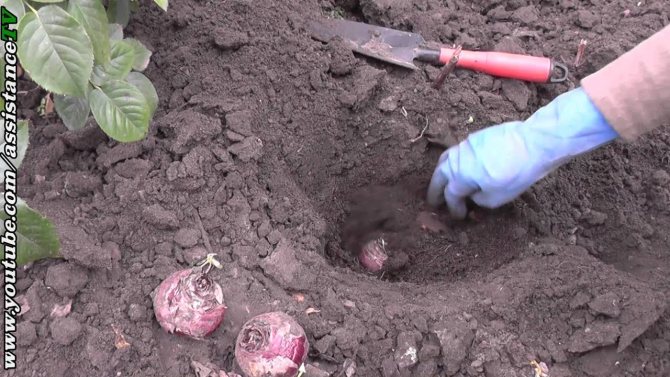

Before planting, the bulbs are placed in a fungicide solution or in a dark pink solution of potassium permanganate for half an hour.
How to plant hyacinths in the fall
Dig holes of the required depth at the required distance and, if you did not bring humus or rotted manure into the soil during digging, throw a handful of fertilizer directly into the holes, then pour a layer of coarse sand 3-5 cm thick into each hole for drainage, lightly press into it is the bottom of the onion, cover the onion completely with sand and finish filling the hole with soil. If you have planted hyacinths in dry soil, be sure to water the area after planting.
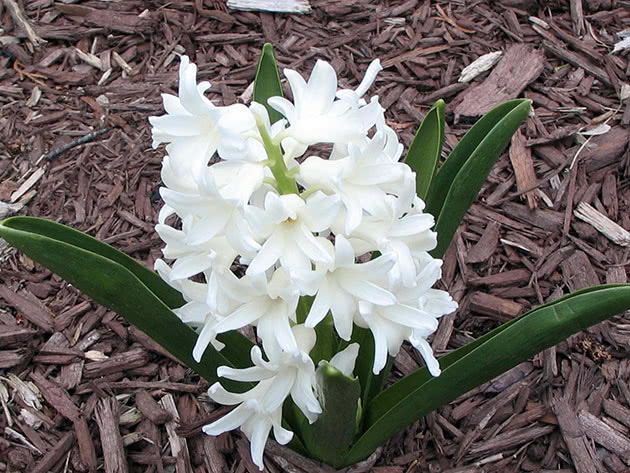

Hyacinths in garden design
Soon after flowering, the leaves of hyacinths lie down, turn yellow and die off, therefore, the placement of plants in a flower garden must be carefully thought out.
- Hyacinths are good in the foreground of a flower garden, when they are covered in front by low-growing primroses.
- Hyacinths also look spectacular between plantings of perennials. Perennial flowers cover yellowed bulbous flowers with their foliage.
- If hyacinths are planted in tree-trunk circles, foliage is removed from the soil surface in early spring so that the flower stalks grow even.
- It is better to plant hyacinths in partial shade, so that on hot spring days, their flowering lasts.
| IMPORTANT! About a week is the difference in the duration of flowering between hyacinths growing in the sun and in partial shade. |
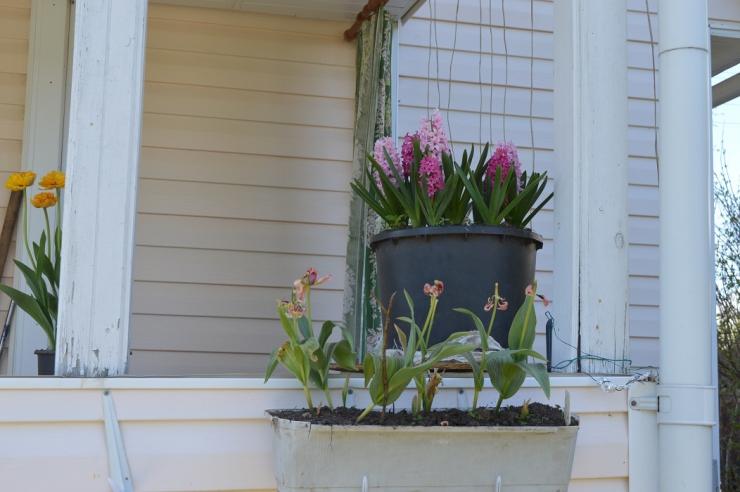

Photo: hyacnts in my garden
Hyacinth care after planting
Hyacinth care in the open field in autumn
In autumn, hyacinths need moderate watering, loosening of the soil and protection from frost. Watering hyacinths is carried out as the soil dries up, and it is necessary to wet the soil during watering to a depth of 15-20 cm, and then it is advisable to carefully loosen the surface of the site. If it's autumn with rains, hyacinths will have enough natural precipitation.
From a sudden cold snap, hyacinths that did not have time to take root in the fall can be protected by plastic wrap, spunbond or lutrasil, which cover the site. However, if three to four weeks have passed since planting, then the coming frosts are no longer terrible for hyacinths.
Since planting hyacinths in the fall involves applying fertilizers to the soil, you no longer have to worry about fertilizing this season, and in the spring you will need to apply nitrogen fertilizers to the soil.
Hyacinth care in winter
When persistent cold weather sets in, you need to cover the site so that the hyacinths do not die from frost in winter. Humus, peat, dry foliage, sawdust or spruce branches are used as mulch. The layer of mulch should be 10-15 cm. Remove the shelter in early spring, as soon as the soil begins to thaw, since hyacinth shoots appear very early.
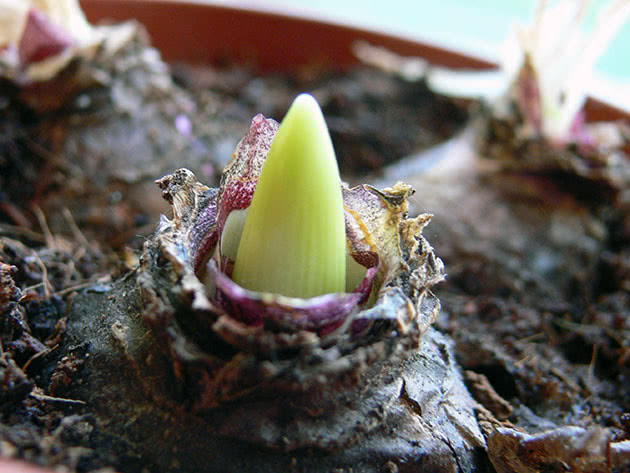

Tips from experienced gardeners
Considering planting and caring for hyacinths in the open field in the fall, there are several basic rules that have been developed by experienced specialists.
One of the important characteristics of this plant is that it can be used both as a houseplant and as a garden plant. That being said, you can enjoy its bloom all year round.
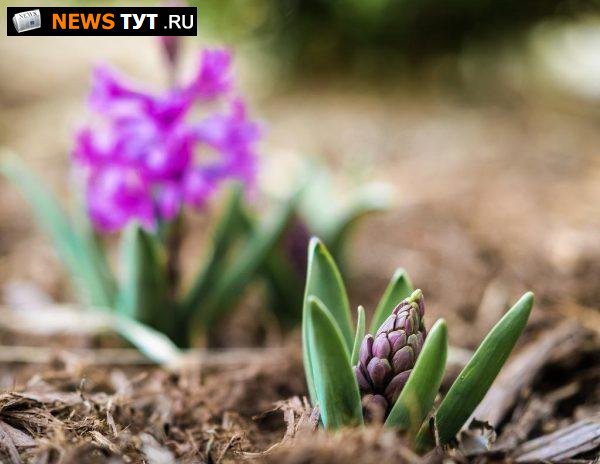

Tips from experienced florists:
Hyacinth is a moisture-loving plant, so it should not only be watered frequently, but it is also better to plant it next to water sources. If you have a pond, then it is best to plant on the banks of this pond. In autumn and spring, it is imperative to feed the plants with various organic and mineral fertilizers. If the winter in your area is cold, then you need to cover the flowers with silage or special film. But it is better to dig it out, then the flowering in spring will be much more abundant and magnificent.
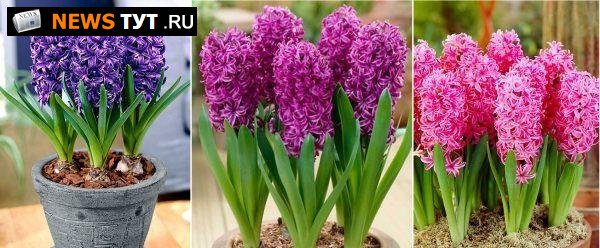

These simple tips will help you get abundant flowering and protect your plant from negative influences.Recently, a considerable number of interesting varieties have appeared that you can purchase for your garden. Therefore, you need to know all the nuances of flower care.
Transplanting hyacinths to another place in the fall
As we already wrote, hyacinth bulbs are dug out of the ground annually. This is done in the summer, when the leaves and flower stalks dry out - in late June or early July. If you leave the bulbs in the soil, hyacinths will bloom poorly next year. When are hyacinths transplanted - in spring or autumn? Like the initial planting, which is carried out from September to November, transplanting hyacinths in the fall is most justified. It is carried out at the same time and according to the same procedure as the initial planting of hyacinths, which we described earlier.
How to grow hyacinth at home?
Care rules:
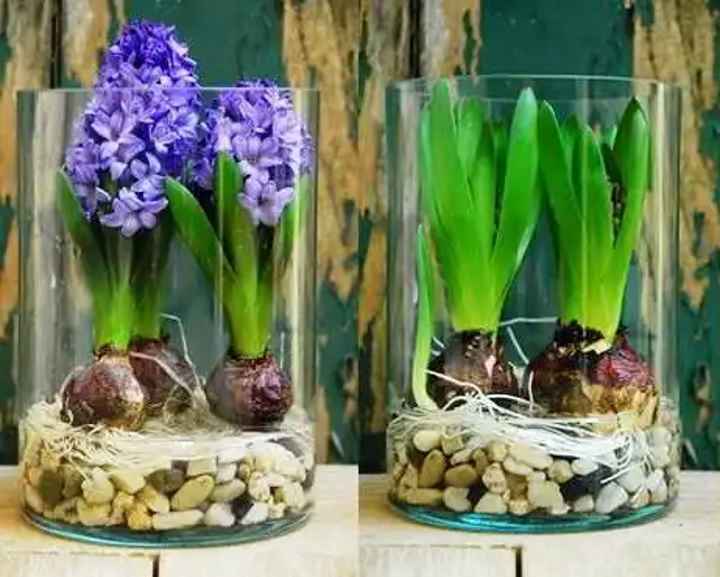

It is advisable to take a flower pot wide and not necessarily deep, with drainage holes;- on the bottom of the pot we put expanded clay or pebbles for drainage;
- we buy ready-made soil or make up from: garden soil, compost, humus, sand and peat;
- on top of the drainage we spread a thick layer of soil and sand, on which we place the onion. There can be several bulbs, if the pot allows, the main thing is that there is a distance of 3 centimeters between them. After that, the bulbs are covered with the rest of the earth.
How to store hyacinths before planting in the fall
The hyacinth bulbs removed from the ground are cleaned, the remaining leaves are cut off, put into plastic boxes with perforations for drying and transferred for 5-7 days in a dry ventilated room with a temperature of about 20 ºC. When the bulbs are dry, unnecessary scales, dry roots are removed from them, the easily departing large children are carefully separated, after which the planting material is sorted by size, placed in one or two layers in boxes, and if there are few bulbs, then in paper bags, and placed on storage.
Reproduction of hyacinths
Hyacinths are propagated by children, which are separated from the mother plant during digging. After planting and germination, they bloom only after 3 years.
Important! The hyacinth bulb lives for about 10 years, but flower growers recommend that this crop be renewed every 3-5 years.
However, this flower does not always give planting material and is stimulated to do so in the following ways:
- Cut out the bottom. After flowering, when the leaves begin to turn yellow, they are dug out, immediately washed and old scales are removed. Large ripe bulbs of good density are selected for reproduction. The material laid out in one layer is dried for a week under a canopy or in a dry ventilated room. Then the bottom with the central bud is cut off with a sharp knife and sprinkled with chopped charcoal. The planting material is placed in boxes with perlite cut off the top. Moistening and planting are covered with plastic wrap to create a greenhouse effect. At the same time, the temperature regime is maintained at + 30 ° C and 100% air humidity. In 2-3 months, by the fall, the emerging "babies" will reach 0.5-1 cm and will have the rudiments of roots and shoots. The mother's bulb with children is planted in open ground and covered with peat. If by this time the cold has already come, then they are placed in a container with soil and kept in the basement or refrigerator at a temperature of + 2 ... + 6 ° C, and in the spring they are planted in the garden. With this method, one onion produces 20–40 babies.
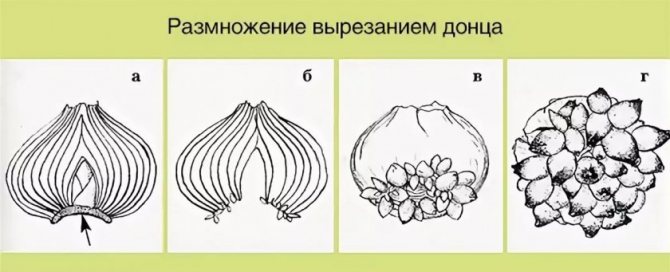

- Cutting the bottom. It gives less planting material (no more than 15 pcs. From each plant), but it turns out to be larger. On large bulbs, two cross-shaped incisions with a depth of 4–6 mm are made on the bottom, and one on small ones. The clipped places are "powdered" with crushed coal. The bulbs are kept in a warm place (+ 21 ° C) for a day so that the incisions open. Then they do the same as in the previous method.
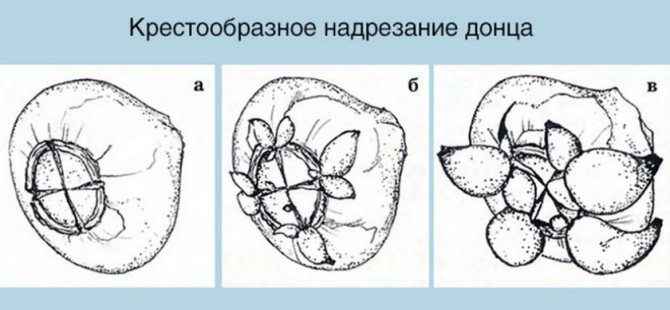

- Scales. This method allows you to get a lot of planting material (up to 50 pcs.). The large mother bulb is divided into 4-6 parts.The scales are separated from the bottom, "dusting" the place of breaking off with coal. Then they are placed in a bag with sand or perlite, which is then tied up and transferred to a warm place with temperatures of + 20 ... + 25 ° C. After 1.5 months, babies appear, and the temperature regime is reduced to + 17 ... + 20 ° С. Lighting should be diffused. In the fall, they are planted in the soil.


- Leafy cuttings. When the hyacinth is just picking up buds, a couple of leaves are carefully cut off from it at the very base. Each of them is cut transversely into 3 parts. The top of the leaf is discarded. The lower and middle parts, at least 6 cm long, are kept for 12 hours in a root formation stimulator. To do this, dissolve the floor of the heteroauxin tablet in 1 liter of water. Then the cuttings are planted in moistened sand with a processed end to a depth of 3 cm and covered with a bag. Observe the mode of + 10 ... + 15 ° С with 90% humidity and diffused lighting. Each stalk takes root and new leaves, and 2–4 babies appear on it. After their appearance, the plants are planted in a nutritious soil.
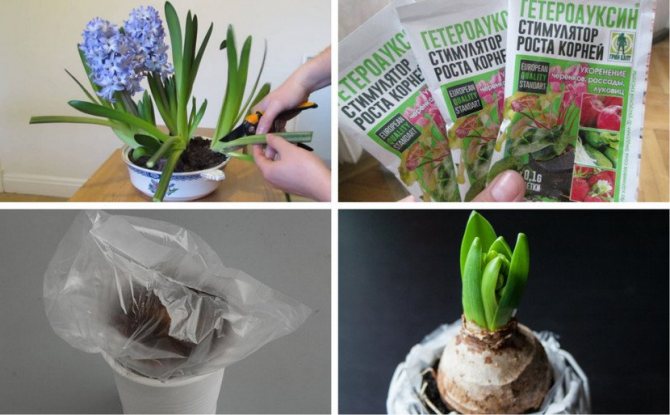

Types and varieties of hyacinths
Today, as a rule, only 3 varieties of hyacinths are distinguished:
- Eastern (Hyacinthus orientalis);
- Transcaspian (Hyacinthus transcaspicus).
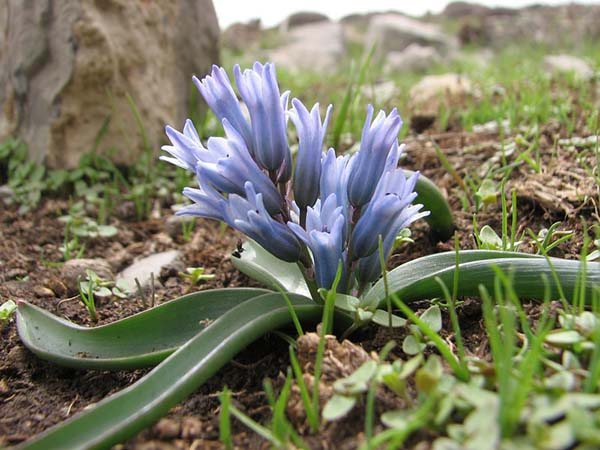

The most famous and suitable for cultivation in our gardens and home conditions in pots is the oriental hyacinth.
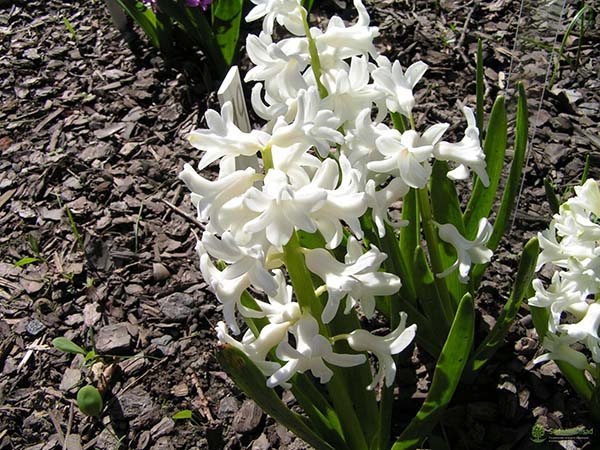

Carnegie variety
There is a fairly large number of varieties of the oriental variety, which in turn are divided by size, color and color of flowers (white, yellow, red, pink, blue, purple, blue, etc.), as well as by the timing of flowering in the early-medium and late flowering, while the difference between their flowering is only one and a half weeks. Therefore, if you do not have the opportunity to come to the dacha early to catch their flowering, it is better to choose late varieties.
Video: types and varieties of hyacinths
When hyacinths bloom
These are early spring flowers that delight gardeners during the same period as tulips. Various varieties with different flowering periods have been bred:
- In the middle of April until the middle of May days, early varieties of hyacinths bloom and smell fragrant. Most often they have blue flowers.
- A little later, varieties of medium flowering bloom. Their color is more varied (lilac, pink, red, white).
- The latest flowering time for hyacinths is orange and yellow.
An ancient legend has survived to this day about the handsome and stately young man Hyacinth, who was in friendship with a god named Apollo. During a sports event involving discus throwing, Apollo accidentally killed Hyacinth. In the place where the drops of his blood soaked into the ground, flowers grew. They began to be called by the name of a young man.
You can do forcing in greenhouses or at home and get flowering plants in January. Before forcing, the bulbs should be stored at a low temperature (no higher than 9 degrees) for several months. 10 - 12 weeks medium and early varieties need to be cooled, late varieties should be kept in a cold place for 14 - 16 weeks. After planting, they begin to bloom after about a month. When stored warm, hyacinths will bloom only by March.
When to plant hyacinths: optimal planting dates in autumn and spring
Naturally, like all bulbous, hyacinths are planted in the fall before winter. At the same time, you need to choose such a time so that the bulbs have time to take root, but do not germinate. That is, if you do this before the necessary time, then the frosts will simply destroy the plant that has sprouted, and if later, then the bulbs will not have time to take root and will freeze again. Therefore, it is very important to know the optimal dates for planting hyacinths in autumn, which will differ depending on the region of your residence and the corresponding climate and weather conditions.
Important! If you planted the bulbs at the right time, but suddenly, according to the weather forecast, a sharp cold snap is expected, then you should increase the layer of mulch or cover the plantings with spruce branches or fallen dry leaves.
Thus, in the middle lane (Moscow region), hyacinths should be planted in the second half of September - early October, in the Urals and Siberia - in late August and early September, and in the southern regions - throughout October.
Is it possible to plant in spring and how to do it
If you were presented with blooming hyacinths in a pot (for example, on March 8 or some other spring holiday), then after they have faded, in order to preserve the bulbs, the plant can be planted in open ground. To do this, you first need to cut off the peduncle so that it does not take excess nutrition from the bulb. You take out the hyacinth bulbs together with the earthen clod and bury them to the same depth at which they grew in the pot, having previously poured a layer of sand on the bottom as drainage. Then cover with nutritious soil and water, wetting the soil around the bulb, and not itself. If suddenly, according to the weather forecast, you find out that return spring frosts are expected, then on this day it is better to cover the plant bulbs with non-woven material. When you see that their leaves are dry, then you should get rid of them by removing with pruners or scissors.
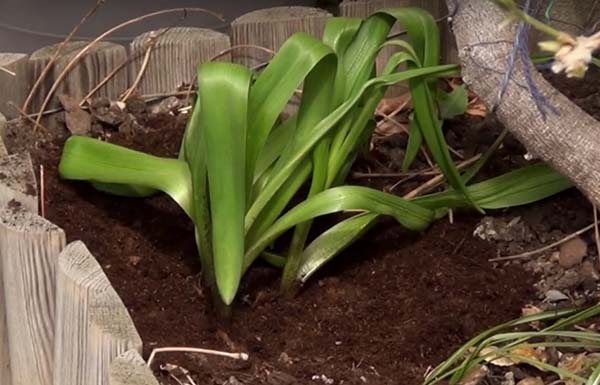

Advice! If for some reason you do not want to plant hyacinths in the spring, then you can do otherwise. Wait until the leaves of the plant dry up and cut them off. After that, get the bulbs, dry them and put them in storage until autumn planting.
Video: planting hyacinths in spring
Growing methods in the Moscow region
In central Russia, hyacinths are grown in gardens, using bulbs for forcing leaves and flowers in greenhouses and at home. The difficulty of growing in the middle lane is weak winter hardiness. The following methods are used for breeding:
- With the help of seeds (in this way the flowers are bred by breeders to develop new varieties).
- The main breeding method is bulbs.
Bulbs for planting must be selected strong so that there is no damage, medium size. Large bulbs are ideal for forcing in winter. It is necessary to examine them well for signs of disease.
How to plant hyacinths outdoors
In order to enjoy the beautiful flowering and the favorite aroma of hyacinths for a long time, it is necessary to provide the most suitable place for planting, as well as prepare the bulbs themselves and the soil for further work.
Pick-up location
A properly chosen planting site can greatly facilitate the cultivation of hyacinths in the garden. At home, these bulbs grow in a very warm and dry climate, so they must be planted in sunny areas, without drafts, where there is not the slightest stagnation of water, otherwise the flowers can rot very quickly due to the presence of a very thin skin.
Many people plant hyacinths under trees because they bloom at a time when there is still no dense foliage. However, it should be borne in mind that trees suck out almost all nutrients from the soil.
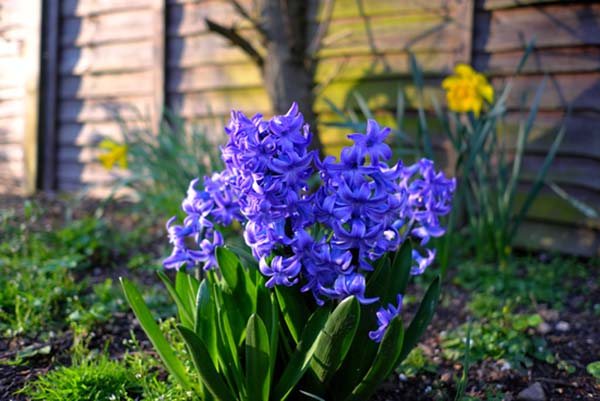

These bulbous flowers look good on flower bed made of plastic bottles.
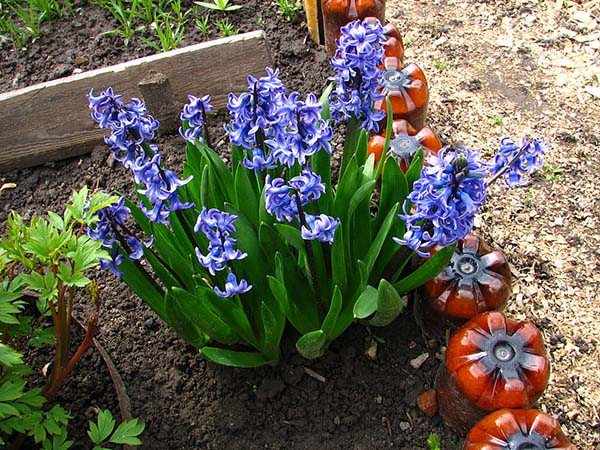

As for the neighborhood, it is beautiful to plant hyacinths with other primroses, for example, with hazel grouses, crocuses, daffodils, bulbous irises.
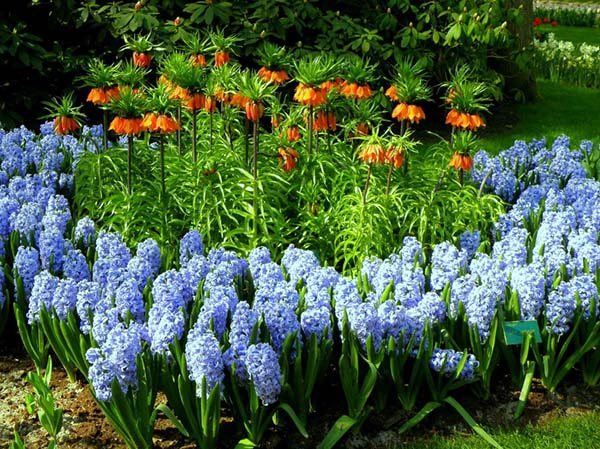

You can put them in a flower bed of tires, for example with tulips.
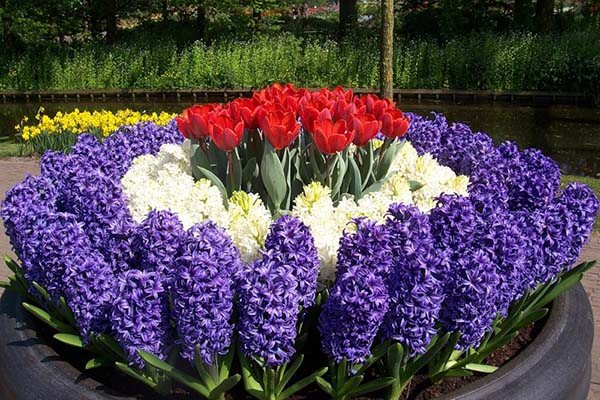

By the way! You can grow hyacinths both in large garden pots and in small containers at home on a windowsill or balcony.
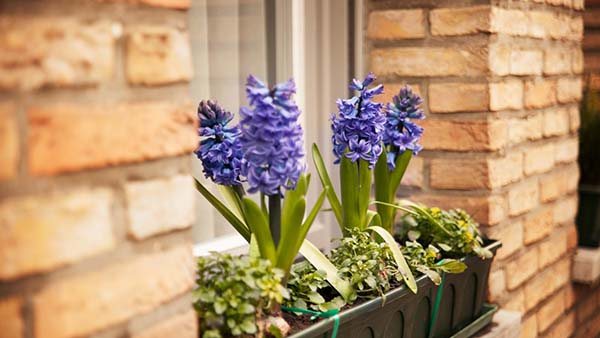

Soil preparation
Hyacinths need a neutral soil, and it is imperative that it be loose and moisture-permeable, in other words, the most suitable is sandy loam.
Before planting, it is advisable to dig up the earth to a depth of 30 centimeters and apply organic fertilizers - compost, humus or peat, wood ash, as well as mineral - superphosphate, potassium sulfate (if there is no ash), or complex - nitroammophos (16% of each macronutrient).And if the soil is heavy (clayey), then the sand is too acidic - limestone (dolomite) flour or, again, more wood ash.
Important! In no case should fresh manure be introduced for digging and planting bulbs.
Selection and preparation of bulbs for planting
Naturally, the purchased onion should be outwardly dry, clean and healthy (without signs of disease and damage, especially at the bottom), and dense and elastic to the touch.
If you want the hyacinth to bloom immediately, it is recommended to choose 4-5 cm bulbs, 2-3 cm bulbs are very young, there will be few flowers, but you should not buy too large 6-7 cm bulbs, these are already quite old specimens that are about to be updated.
Storing the bulbs
Experts recommend digging up the hyacinth bulbs every year. In some cases, a given plant crop can remain in the ground for 3 years, but in order for the bud to form well for flowering, the bulbs must lie for 3 months in a warm and dry place.
Important! Immediately before planting, the bulbs are recommended to be placed in a solution with a fungicidal agent (foundation). This will increase the resistance of the bulbs to diseases and pests.
If they are left in the ground, then the flowering will be weak, or even stop altogether. Therefore, after the flowers have completely bloomed and the leaves begin to turn yellow (usually in June), the bulb is carefully dug out, maintaining a gap of 7-10 cm from the plant.
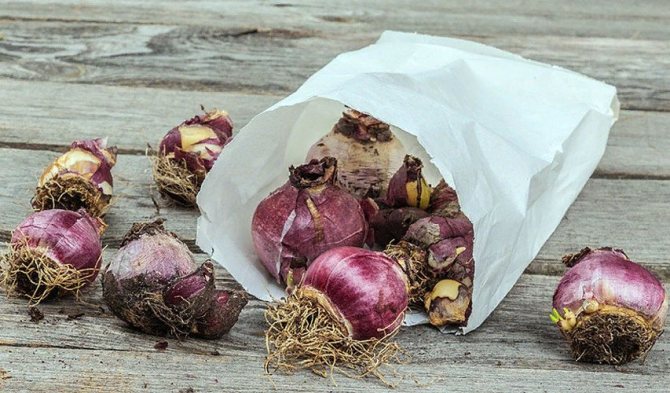

Initially, they should be stored at a sufficiently high temperature regime, which reaches + 24 ... + 30 ° С. After that, the temperature is reduced to + 17 ... + 18 ° С.
The bulb heads are washed under water, rejecting specimens unsuitable for planting. You can use potassium permanganate of low concentration for this purpose. Then the bulbs are blotted with a towel and dried. The specimens selected for planting are cleaned of dried scales and dry roots are cut off. Then they are placed in a cardboard box, bag or other suitable container. If desired, each piece can be wrapped in a newspaper.
Video: Storing Hyacinth Bulbs
Outdoor hyacinth care
Some time after the autumn planting, when the first cold snap begins, if you have not previously mulched your future flower bed with hyacinths, you need to do this now, and even better, cover it with spruce branches or dry fallen leaves (you should not do a heavy shelter), you can use straw.
And in early spring, when the snow melts and you first come to the dacha, the entire shelter will need to be eliminated so as not to interfere with the sprouts making their way towards the sun.
Blossoming of hyacinths, as a rule, occurs in April-May, and the duration is only 1-2 weeks.
Advice! There is a little trick on how to get bigger and taller colors. Namely, in the period before the beginning of budding, you need to cover the flowerbed with hyacinths with a dark (black) film, due to a lack of light, the sprouts will begin to stretch, thereby the peduncles will noticeably increase in height.
Watering
Watering hyacinths should be taken seriously, stagnation of moisture is contraindicated for bulbs, but the earth should not dry out, so try to moderately and shallowly moisten the flower bed. Especially often (but not abundantly) it is necessary to water the plant during the period of its budding and the beginning of flowering, as well as within 2 weeks after.
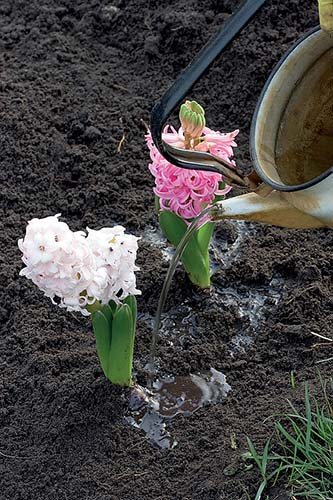

Advice! Do not forget to loosen the soil after each watering so that the ground does not crack and the flower bed looks beautiful.
Top dressing
Top dressing is a very important point of care in growing hyacinths. The standard scheme looks like this (* the consumption of any mineral fertilizer is about 40 grams per 10 liters of water, or better according to the instructions on the package):
- The first top dressing must be done immediately after the first shoots appear, at this moment the plant needs nitrogen to grow the leaf mass (for example, it can be urea, ammonium nitrate or some kind of green fertilizer).
- The second time is fed shortly before flowering, that is, during the budding period - to obtain lush flowers. At this point, the plant needs potassium-phosphorus feeding (more potassium) and a little nitrogen (for example, you can use potassium chloride or ash and superphosphate, as well as a little urea or ammonium nitrate, although nitrogen is already present in the superphosphate itself, therefore, additional fertilization can be dispensed with).
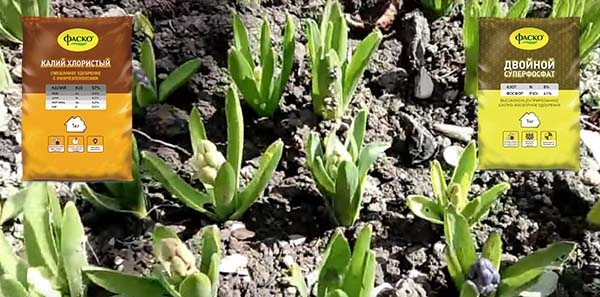

- The last (third) top dressing is at the end of flowering. The plant needs more phosphorus and a little potassium (i.e. superphosphate and potassium chloride or ash).
Thus, if you water and feed hyacinths in a timely manner, they will delight you with their beautiful, lush and fragrant flowering.
And after flowering, be sure to cut the peduncles so that the plant directs all its forces to provide the bulb. Now it remains to wait until the leaves of the flowers fade and turn yellow, so that they can be dug up for the summer before the next autumn planting.
Soil requirements
Gardeners need to consider some of the soil requirements for planting. Hyacinths love neutral soil. If the soil is alkaline, then acidify it a little, and if it is acidic, then add lime. For the good development of hyacinths, a loose and breathable soil is important. If necessary, you can add a baking powder to the soil: river sand or vermiculite.
Monitor the fertility of the soil, provide the necessary nutrition for hyacinths. Add superphosphate (70 g per m2), rotted manure (10 kg), wood ash (200 g) to the soil. Dig up the site for planting the bulbs to a depth of 35-40 cm along with the above dressing. Start preparing the land from the end of July - beginning of August.
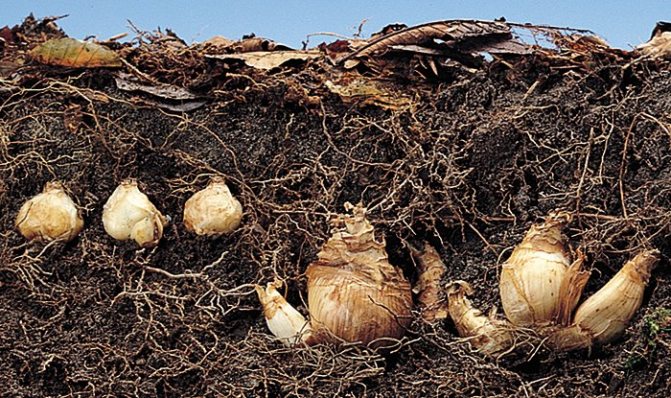

Disembarkation at the house
Planting hyacinth bulbs in a pot is done in November. Its bottom is covered with drainage from broken brick or expanded clay. The soil should be composed of equal amounts of turf, peat and river sand. The pot is taken out in a cool dark place for 40-45 days, all this time the soil is moistened.
After the appearance of 8-10 cm sprouts, the hyacinth is brought into a warm room and gradually allowed to get used to the light, periodically covering it with a paper cap.
Hyacinths begin to bloom after three weeks of warmth. If you create at home temperature conditions in the range of 10-12 ° C, the plants will flourish for up to 25 days, if it is warmer (about 20-22 ° C), this period will be shortened and will be about 15 days.
After flowering, you need to let the bulbs dry and rest, after which you can transplant it into open ground.
Useful Tips
When planting hyacinths, the following recommendations should be considered:
- We calculate the landing depth correctly. If the depth is insufficient, the bulb may freeze. Excessive deepening will lead to a delay in the growing season.
- We throw away bulbs that cause even the slightest doubt, as they can infect other flowers and ruin the entire flower garden.
- When planting bulbs of different sizes, we plant large ones first, and after them medium and small ones.
How to choose planting material
The beauty of hyacinth lies in its bloom, which is mesmerizing with its colors. The health of the bulb and peduncle depends on the correctly selected planting material.
- When buying a bulb, you need to pay attention to its volume. A healthy bulb is 4 to 6 cm in diameter. Smaller bulbs are not suitable for autumn hyacinth planting.
- A healthy bulb should be dense, without cracks, rotting, stains, damage. A weak bulb is very unstable to disease and can infect an entire garden bed.
- Too large bulbs are used for home distillation for various celebrations.
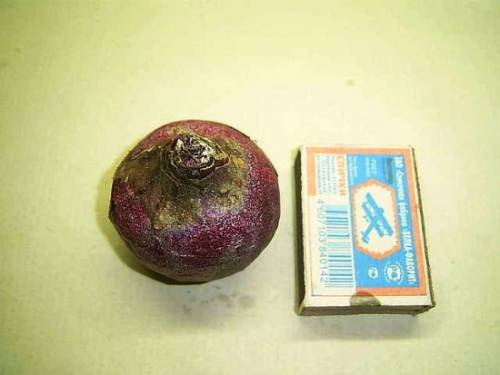

Mulching before winter
By the cold winter, the area with hyacinths should be insulated. To do this, use mulch. The covering layer must be at least 10 cm.As a shelter, you can use sawdust, peat, spruce branches, dry foliage, needles. Remove the mulch with the onset of spring. When the soil thaws and warms up a little, hyacinth shoots will appear. Their bulbs germinate very early, along with tulips and daffodils.
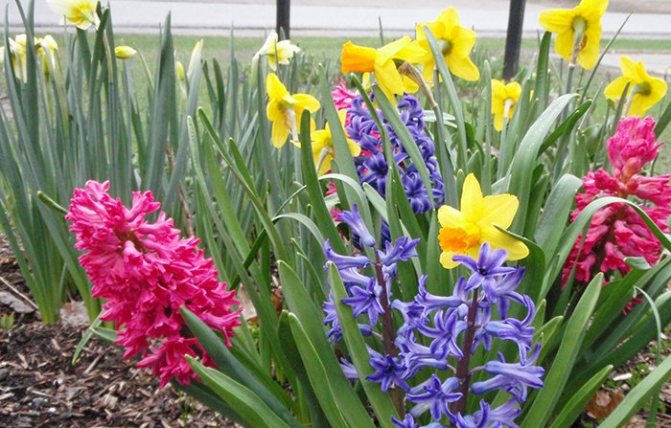

Bulb selection criteria
Bulbs for planting hyacinths in the fall must be healthy, free from rot, mold and traces of pests. The size is chosen average, with the ratio of the diameter of the lower part to the body 1: 1.5. Too small planting material will not survive the winter.
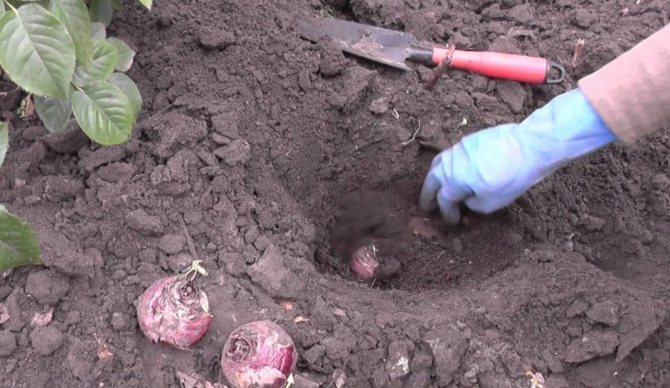

Bulbs for planting hyacinths in the fall must be healthy, free of rot, mold and traces of pests
The surface of the bulbs should be smooth and dry and firm to the touch. A well-developed neck is encouraged. If onions with foulbrood, wounds or other damage are caught, they are discarded.
Preparing a flower bed for planting
Planting hyacinths correctly in the fall is very important as this will allow for very good flowering. It is important to choose the right place for planting flowers. The site should be well lit and protected from cold winds. Many people try to plant bulbs under trees, but this is not entirely correct, since this only partially protects the plant from sunlight and wind, and after flowering, the bulbs suffer greatly from insufficient nutrition.
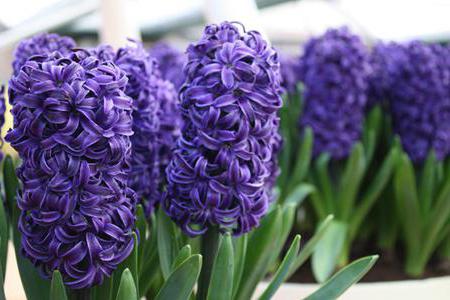

Planting hyacinths in open ground in the fall requires preliminary soil preparation, which must be carried out in advance. This is best done during the last months of summer. The bulbs require loose soil, so peat or river sand should be added to the black soil. It is not recommended to plant them in acidic soil. The acidity should be no more than 6.5, and if it is higher, then you need to add lime flour.
Groundwater located next to the root system can provoke the formation of fungus, so good drainage is needed. You can plant the plant in high beds or create a slight slope to ensure better moisture drainage. Before planting hyacinth bulbs in the fall, you need to dig up the beds 40 cm deep and add:
- superphosphate;
- limestone;
- wood ash;
- peat and sand;
- rotted manure and humus.
The flower bed must be prepared in advance so that the soil has time to settle a little. If you prepare the soil immediately before planting the bulbs, the soil will settle as the roots grow, causing them to break off.
Gardening Tips
For beginner flower growers, it will not hurt to know a few tips for the correct planting of hyacinths in the fall. When and how to plant, it will become clear to you after some recommendations. By doing them, you will achieve abundant flowering in the spring.
- Choose quality planting material. When choosing bulbs, pay attention to their appearance. Make sure that there is no damage or rot on them.
- To prevent the bulbs from rotting in the ground, treat them with a solution of potassium permanganate or any other fungicide. Soak them in the solution for 10-15 minutes.
- Pay attention to the correct choice of the site. Observe the crop rotation, do not plant hyacinths in the place where other bulbous flowers grew.
- After digging in the beds, you can check the soil temperature at a depth of 15 cm. The best temperature for planting the bulbs is between +5 and +10 ° C.
- You can plant hyacinths in rows. This will help simplify the preparation of the landing site: you will not need to dig single holes, but simply make a shallow trench.
- Never add fresh manure to the garden or hole. Use already rotted fertilizer for feeding.
- If you decide to plant several varieties of hyacinths, then plant large bulbs first, they need a longer time to root. Plant small specimens after a week. Medium bulbs are considered the most hardy.
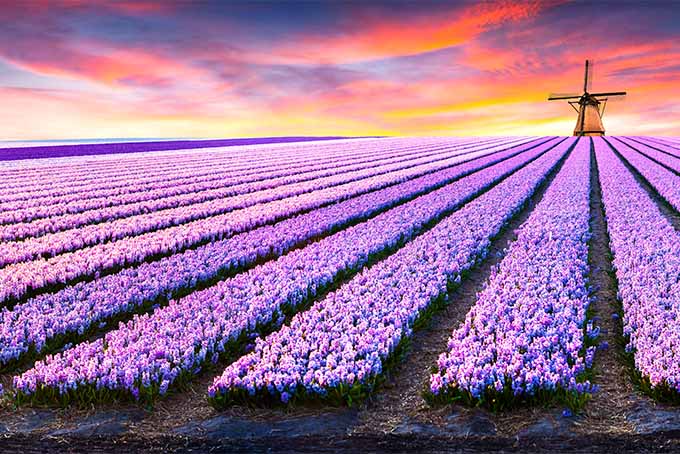

Preparing for winter
In winter, when the weather turns steadily cold, it is important to mulch the hyacinths.The layer of mulch is at least 10 cm, and the material used can be anything: sawdust, peat, spruce branches, and even dry foliage collected from the site are suitable.
Such a shelter will help fresh plantings to endure the cold. It must be removed in the spring, as soon as the soil begins to thaw, since the seedlings of the planted hyacinth bulbs appear very early, and the old caked mulch will only interfere with them.
Testimonials
Olga
“I was given a hyacinth on March 8th. When it faded, I took it out of the pot. He lay down a little, dried up, and then I planted him in the soil. Now green leaves have appeared from the ground and a flower has already begun to cut through. "
Maria
“I bought a couple of onions in September. When I got home, I put them under the bathtub and successfully forgot. After one or two months, someone from the family moved them to the refrigerator, on the top shelf. After the New Year, I remembered my purchase and decided to check the condition of the "material". What was my surprise when I found small green sprouts on the top of the bulbs. I planted them in pots and in the spring I enjoyed the wonderful smell. "
Hyacinths are beautiful spring flowers that require little maintenance. The main thing is to adhere to the basic rules for planting them and take into account our recommendations for caring for them.
Storage of hyacinths
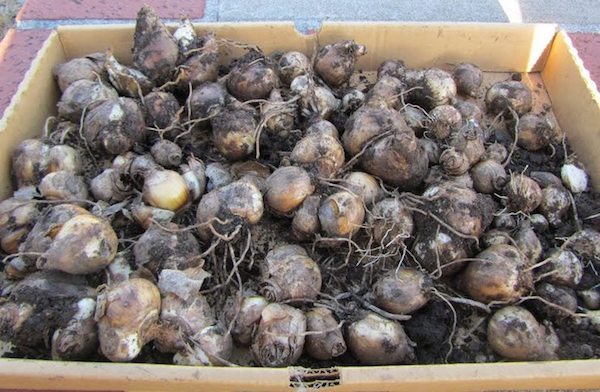

To get high-quality hyacinth planting material for autumn planting, it is necessary to properly store it in the summer.
Plants are removed from the soil after flowering, when the aboveground part turns yellow and dries up. They try to carry out the digging in dry weather.
Hyacinth bulbs are freed from the ground, stems. If necessary, the baby is separated. At home, it is convenient to store hyacinth planting material in cardboard boxes, in a dry and dark place. The storage temperature of the bulbs should not fall below +22 degrees.
How to keep hyacinth bought in winter?
Sometimes hyacinth planting material is purchased in the store in winter. You can save the bulbs until spring in the refrigerator at a temperature of +3 degrees. The flower bulbs are placed in a plastic bag with holes for air flow, slightly damp sawdust or peat is poured inside.
Blooming hyacinths in a pot are often purchased in the store. Typically, this is a "disposable" plant, intended to be discarded after flowering. But hyacinth can be saved by removing the bulb from the pot after flowering and planting it in the ground in the fall as described above. You can also use the information from the video:
Problems with growing hyacinths
- Some gardeners do not plant hyacinth bulbs in the fall, but in the spring. This cannot be done, because the natural process of development gets confused. There will be no flowering in the year of planting. For the formation of a peduncle, the plant needs special conditions, which can only be provided by annual digging.
- Hyacinths do not bloom well if the planting site is not chosen correctly. These plants are light-loving, they need warmth. A place for landing is selected without drafts, in an open sunny area.
- Hyacinth bulbs get sick and rot from the proximity of groundwater. The beds are made inclined so that there is no stagnation of melt water.
- Hyacinth inflorescences are short, fall out of the socket, flowers are underdeveloped. This is due to early planting, excess moisture in the soil, or improper storage of the bulbs.
Planting dates for hyacinths according to the lunar calendar 2019
When choosing the time to plant a flower crop, you can also focus on the cycles of the moon. But first of all, of course, you need to rely on weather and climatic conditions.
Auspicious days:
- in August - 4-6, 18-23, 28, 29;
- in September - 1-5, 7-10, 17-24, 26, 27, 30;
- in October - 4-7, 9-12, 15-17, 19-21, 23-27.
Unfavorable days:
- in August - 15, 16, 30, 31;
- in September - 14, 15, 28, 29;
- in October - 14, 28.
Preparing the bulbs for planting
For planting, it is important to use only healthy planting material. Hyacinth bulbs without signs of ailments look like this:
- medium and large head size (diameter 4-5 cm), small onions may not survive the winter;
- bulbs dense to the touch, with a smooth and dry surface;
- without traces of rot, wounds, sores;
- the bulb has a well-developed neck.
Dried, rotten and damaged bulbs are discarded.
On the day of planting, hyacinths are treated in a fungicide solution (Alirin, Agate, Maxim, Fitosporin, Potassium Permanganate). Half an hour is enough for processing, the concentration of the solution is done according to the instructions. Potassium permanganate is diluted to a rich pink color. After pickling, the bulbs must be dried.
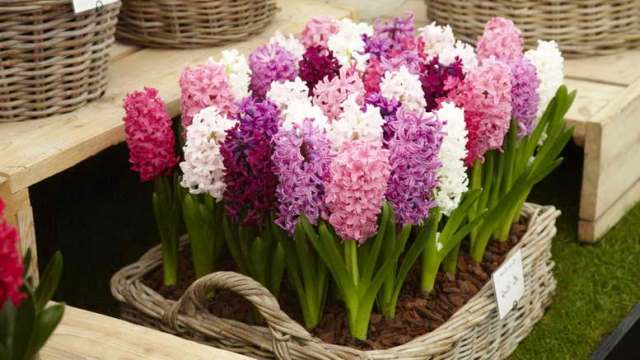

Features of preparing flowers for the winter
Once the bulbs are rooted, they are no longer afraid of any frost. However, it is still necessary to protect them from frost in winter. For the winter, it is imperative to carry out warming of plants. Additional insulation will be a layer of snow.
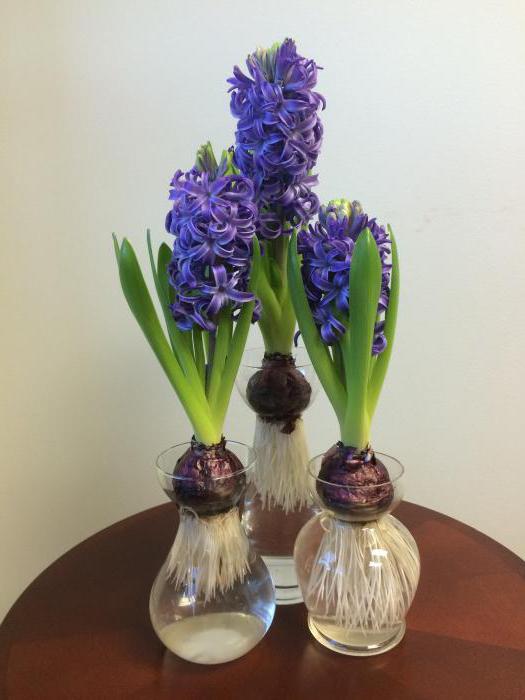

Observing all the rules for planting hyacinths in the fall, there is no doubt that the first shoots will appear in early spring. It is imperative to monitor the weather conditions until the flowers are still well rooted. It is advisable to prepare the covering material in advance. In spring, timely fertilization is required so that you can get a beautiful and abundant flowering.
Choosing a landing site
Hyacinth is a favorite plant of many flower growers. But in order for it to impress with its natural beauty, it is required to organize proper care for it. For the proper development of the plant, it is necessary to devote a lot of time to it.
Hyacinth is a thermophilic flower. Therefore, it is important to find a suitable location on the site. It is also important for successful development that the soil is well fertilized.
When choosing a place, it is better to give preference to open areas, so that the sun's rays unhindered and warm the space on which the hyacinths will be planted. Only a slight partial shade is allowed to increase the flowering period.
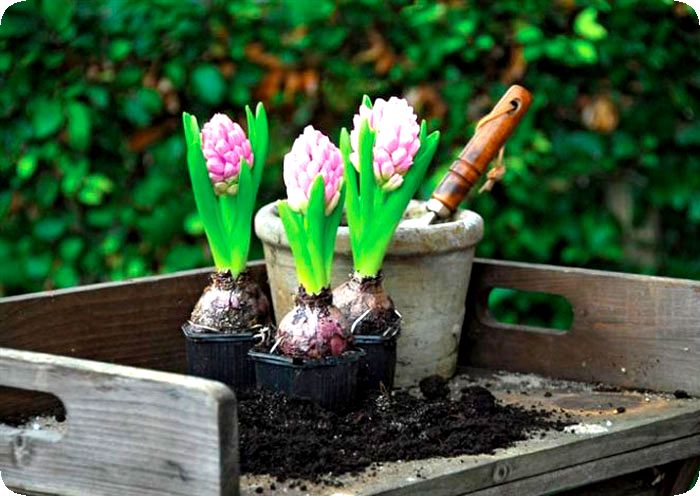

Since the flower is thermophilic, areas with high wind blowing should be avoided. It will be possible to avoid drafts if at some distance from the flower garden there is a building or a garden with tall fruit trees.
Tall trees or shrubs should not be in close proximity to the flower garden. Tall plants will act as unwanted neighbors for hyacinths, taking nutrients and water from the soil.
When choosing a place for planting hyacinths, it is better to immediately abandon the idea of \ u200b \ u200bbreaking a flower garden in an area with a high groundwater level. Hyacinth needs abundant watering, but the constant stay of the bulbs in moist soil will provoke various diseases and lead to the death of the flower.
Florists pay attention to the fact that such a bulbous plant prefers a loose and slightly alkaline soil.
However, if the soil in the selected area differs in structure and composition, the situation can be corrected. Dolomite flour, chalk and lime are added to the acidic soil. If the soil is clayey, river sand or vermiculite is added to it.
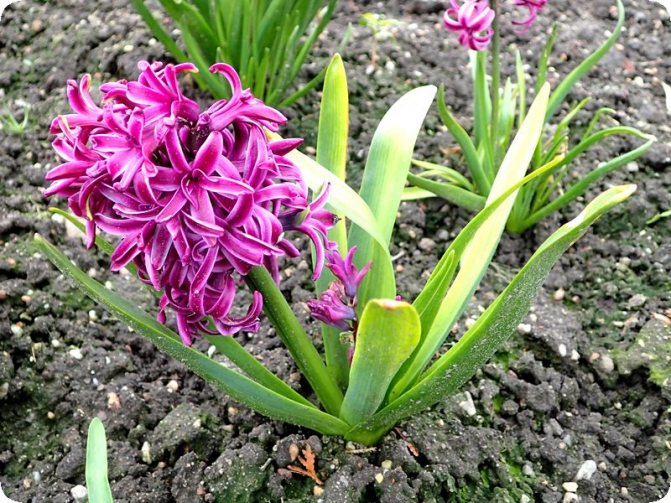

It is recommended to pay attention to the predecessors when choosing a site for planting flowers. You cannot plant hyacinths in the same area for more than four years.
It is also not recommended to plant hyacinths where tulips, gladioli or other types of bulbous plants previously grew. They are prone to the same diseases, so when hyacinth is planted in the same areas, the risk of disease or pest damage increases.
The best precursors for hyacinths are:
How to feed properly?
The main part of mineral fertilizers (phosphorus and potash) should be applied in autumn when planting.It is good to fill the soil with wood ash, preferably from deciduous trees. With the beginning of spring, mainly nitrogen fertilizers (urea, ammonium sulfate, ammonium and sodium nitrate) are applied. Average rates (in grams with the active substance per season per 1 sq. M) are N: P: K = 10:15:15. Chlorine fertilizers tend to be avoided. Phosphorus is absorbed slowly, and therefore it accumulates in old cultivated soils, which are annually fertilized with mineral fertilizers. In such areas, it is either not applied at all or the dose is reduced.
Which bulb to choose?
The maximum size of adult bulbs is 4 to 6 cm, depending on the cultivar. Terry and yellow are usually smaller. The bulbs must be firm, with a smooth surface, without mechanical damage and signs of disease, with a pronounced neck and shoulders. An important indicator of their quality is the ratio of the bottom diameter to the diameter of the bulb itself. If it is 1: 1.6 or more, everything is in order. In old and poorly grown bulbs, the bottom diameter in relation to the bulb diameter is less than 1: 1.6.
It is better to plant at a later date.
Best time planting hyacinths in the middle lane, October -1-15, so that the bulbs take root before the soil freezes in the second half or end of November. Many people believe that it is all about a suitable soil temperature of 5-9 °, which promotes regrowth of roots. And early planting in warm soil with a temperature of more than 10 °, they say, worsens flowering, although most often it is the result of incomplete formation of inflorescences due to a dormant period interrupted too early. It is for its extension that the bulbs are planted at a later date (and not in September, like other bulbs). However, hyacinths can be planted until the first half of November. But then the place should be insulated in advance with leaves or other material from those that are at hand, and protected with a film from rain and snow. And after planting, re-lay the insulation.
Landing in ridges is the most comfortable
It is convenient to plant single bulbs with a scoop, they dig a hole with a diameter of 10 cm and a depth of at least 25-30 cm.Then, to a depth of 15 cm, it is covered with a nutrient mixture with fertilizers, a layer of sand on top, and a bulb is already placed on it. Carefully fill the well so that the bulb does not overturn, fill it to the top with light fertile soil. If there are many hyacinths, they are planted on ridges 15-20 cm high to protect the bulbs from melt water. In the spring, the ridges quickly warm up, they have good aeration of the upper layer. In addition, it is easy to install a film cover on the ridges. They are planted in rows at a distance of 20-25 cm, at least 3 bulb diameters are left between adjacent bulbs in a row (for adult bulbs, 12-15 cm). Planting depth is 4-5 times the height of the bulb (15 cm from the bottom for large bulbs). In an area with a low groundwater level, a deeper planting (by 25 cm) is also possible to protect against freezing. But then the peduncle will be lower. The soil in the row is cultivated to a depth of 40-45 cm. The nutrient layer (below the bulb) is made up of ripe humus, garden soil and sand (on clay soils). Phosphorus-potassium fertilizers are added, in total 30-46 g of the active ingredient per 1 sq. M. It is helpful to add wood ash. The bulbs are placed on a 1-2 cm layer of sand and covered with light soil without fertilizers. It is even more effective to completely remove the soil to a depth of 40-45 cm, lay a prepared fertile layer of 20-25 cm, compact it, pour 1-2 cm of sand and spread the bulbs on it. Labels are installed and then covered with soil without fertilizer (you can also take it out if it is light enough).
Do not be lazy to cover for the winter
To protect the bulbs from severe freezing, the ridges are covered. This can be done immediately after planting and before the frosty days begin. Dry leaves, small scraps of thin branches, straw, needles, rotted sawdust are used. They are laid in a layer of 20-25 cm, going over the edge of the planting at the same distance.Snow is also used for additional cover. As it melts, the shelter is carefully removed, trying not to damage the fragile shoots, which by this time are showing up from the thawed ground.
From germination to digging - the time of "close communication"
After the spring waters disappear at the beginning of the regrowth of the shoots, the first liquid top dressing is done. It contains mainly nitrogen (N: P: K = 15: 5: 5 g of active ingredient per 1 sq. M). The second is during the budding period (N: P: K = 5: 10: 5). If the soil during the autumn planting was well filled with organic and mineral fertilizers, then these dressings can be omitted. The third top dressing immediately after flowering before the leaves lodge (P: K = 10:10). Each feeding is accompanied by watering, water helps to deliver fertilizers to the roots in the lower nutrient layer of the soil and flushes the upper one. Drops of liquid should not fall on leaves and flowers. The top layer of the soil must be loosened. This is done very carefully so as not to damage fragile plants. During examinations, plants with obvious signs of disease are destroyed. Other types of impurities are either removed or marked with labels and on planting plans to be separated during digging. The flowering time of hyacinths depends on the weather much more than tulips or daffodils. Hyacinths are more responsive to heat: their shoots always appear after thawing the soil and warming, later than tulips and even daffodils, but in warm weather hyacinths overtake them and bloom earlier. I have been growing hyacinths in the Moscow region for 35 years. Over the years, the beginning of flowering fluctuated on a monthly basis (from April 15 to May 14). For example, in 2000 the spring was delayed. Snow and water on the site melted only on April 5-7, and then it became very warm - in the afternoon about 20 °. The entire period from the emergence of sprouts to the first flowers, which opened on April 17, in the early varieties was only 10-12 days (and this is without covering with a film). The beginning of flowering of different varieties in one season differs by 10-12 days. The duration of flowering of an individual plant is 8-12 days, and under favorable conditions in some varieties up to 20 days. Surprisingly, the timing depends on the color. Usually blue and blue varieties bloom early, yellow and orange - later. The leaves and stem continue to grow for some time after flowering, and then lodge and dry out quickly. Hyacinths bloom earlier, and bloom more amicably and longer if covered with a film. In addition, it is protection against frost and wind.
When and how the flower is laid
Each year, a regeneration bud, or replacement bud, forms in the hyacinth bulb. It is in it that the flower and all the leaves that appear on the plant in spring develop.
The time when a replacement bud begins to form in the bulb is the period of relative dormancy of the plant. In their natural environment in the hot south, hyacinth bulbs lie in the ground and gradually ripen, in colder countries this process takes place in the ground during the cold season.
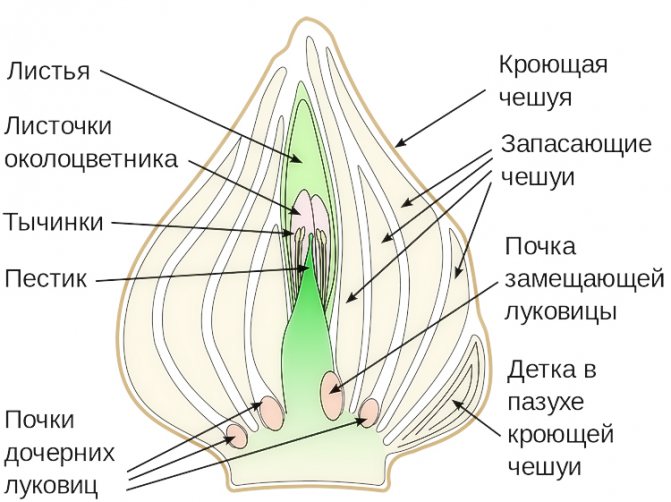

It is necessary to pay attention to the quality of the storage scales - the upper layers of the bulb. The storage scales feed the replacement bud and give up all their juices for the formation of future flowers and leaves.
Hyacinth bulbs should not be stored too tightly, squeezed or thrown - all this prevents the plant from developing normally and harms it.
With the right approach, planting and growing hyacinths is no more difficult than working with other flowers. With some skill it is possible to grow an entire garden of these vibrant and fragrant flowers.

